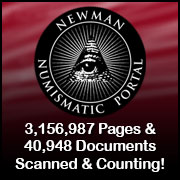
About UsThe Numismatic Bibliomania Society is a non-profit association devoted to the study and enjoyment of numismatic literature. For more information please see our web site at coinbooks.org SubscriptionsThose wishing to become new E-Sylum subscribers (or wishing to Unsubscribe) can go to the following web page link MembershipThere is a membership application available on the web site Membership Application To join, print the application and return it with your check to the address printed on the application. Print/Digital membership is $40 to addresses in the U.S., and $60 elsewhere. A digital-only membership is available for $25. For those without web access, write to: Charles Heck, Treasurer AsylumFor Asylum mailing address changes and other membership questions, contact Chuck at this email address: treasurer@coinbooks.org SubmissionsTo submit items for publication in The E-Sylum, write to the Editor at this address: whomren@gmail.com
BUY THE BOOK BEFORE THE COINSale Calendar
|
- WAYNE'S WORDS: THE E-SYLUM OCTOBER 4, 2020
- KOLBE-FANNING AUCTION SALE 157 ANNOUNCED
- NEW BOOK: CASH IN YOUR COINS, 4TH EDITION
- NEW BOOK: AUSTRALIANS AWARDED 2ND EDITION
- OPITZ ODD & CURIOUS AND TRADITIONAL MONEY ON NNP
- VIDEO: GREATER TULSA COIN CONVENTION
- AUDIO: OXFORD'S EARLIEST COIN COLLECTIONS
- PCGS ANNOUNCES NFC TECHNOLOGY FOR SLABS
- NOTES FROM E-SYLUM READERS: OCTOBER 4, 2020
- SEEING STARS ON UNITED STATES COINAGE
- AMERICAN BANK NOTE COMPANY PARAGUAY ALBUM
- VOCABULARY TERM: NARRATIVE RELIEF
- CHARLES "CLARKE" ELLSWORTH GILHOUSEN (1869-1952)
- WILSON DOLLAR CENTENNIAL MEDALS
- ANA MONEY MUSEUM REOPENS TO PUBLIC
- 2020 ANA AWARDS
- THE MAURICE STORCK COLLECTION
- THE JOHN ROSE BRITISH TOKEN COLLECTION
- NUMISMAGRAM MEDAL SELECTIONS: OCTOBER 2020
- EDWARD I GROAT
- 13TH CENTURY ISLAMIC PRESENTATION GOLD COIN
- WASHINGTON QUARTER AND PEACE DOLLAR PLASTERS
- HALF CENTS STRUCK ON TALBOT, ALLUM & LEE TOKENS
- TENDER: AN EDGE-LETTERED CENT ART PROJECT
- THE HORSE GAMING TOKENS OF SZECHUAN
- CRIMEAN WAR MEDALS OFFERED
- STEVENS MEDAL FOR STUDENTS IN ART
- OFF-CENTER SILVER WASHINGTON QUARTER BROCKAGE
- AFRICAN-AMERICANS AND THE FREE SILVER CAMPAIGN
- MAGGIE LENA WALKER'S SAVINGS BANK
- RITUALLY-KILLED COINS?
- LOOSE CHANGE: OCTOBER 4, 2020
- LOST LANGUAGES DISCOVERED
- FEATURED WEB PAGE: CHILEAN NITRATE TOKENS
Click here to access the complete archive
Click here to unsubscribe (scroll down)
To comment or submit articles, reply to whomren@gmail.com
Content presented in The E-Sylum is not necessarily researched or independently fact-checked, and views expressed do not necessarily represent those of the Numismatic Bibliomania Society.
WAYNE'S WORDS: THE E-SYLUM OCTOBER 4, 2020
 New subscribers this week include:
Robert Gordon.
Welcome aboard! We now have 6,564 subscribers.
New subscribers this week include:
Robert Gordon.
Welcome aboard! We now have 6,564 subscribers.
Thank you for reading The E-Sylum. If you enjoy it, please send me the email addresses of friends you think may enjoy it as well and I'll send them a subscription. Contact me at whomren@gmail.com anytime regarding your subscription, or questions, comments or suggestions about our content.
This week we open with the latest Kolbe & Fanning numismatic literature sale, two new books and updates from the Newman Numismatic Portal.
Other topics this week include odd & curious money, Oxford's earliest coin collections, new slab technology, stars on U.S. coinage, early numismatic literature of Canada, collector C.E. Gilhousen, the ANA museum, auction previews, half cents, a new edge-lettered cent, horse gaming tokens, and ritually-killed coins.
To learn more about Woodward's very rare "A" sale, the rabbit hole coin find, the American Bank Note Company, the Antiquarian and Numismatic Society of Montréal, Alfred Sandham, narrative relief, Barbara J. Gregory Outstanding Club Publications, the Maurice Storck Collection, the Alaska–Yukon–Pacific Exposition medal, Laura Gardin Fraser's unadopted plaster for the Washington quarter reverse, and celebrated ventriloquist Mr Joseph Askins, read on. Have a great week, everyone!
Wayne Homren
Editor, The E-Sylum
KOLBE-FANNING AUCTION SALE 157 ANNOUNCED
As noted last week, the next Kolbe & Fanning numismatic literature sale features the P. Scott Rubin library. Here's the announcement. -Editor
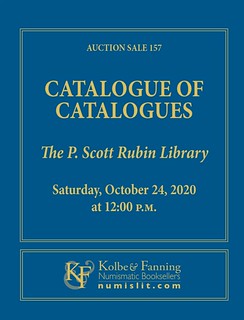 Kolbe & Fanning Numismatic Booksellers are announcing our Sale 157, which will be held on Saturday, October 24, 2020. The 500-lot sale features highlights from the extraordinary library of American coin catalogues collected over the course of more than 50 years by P. Scott Rubin. Including catalogues published between 1851 and 2020, the Rubin Library is the most extensive and wide-ranging library of American coin catalogues to be offered in many years—and perhaps ever. While most of the catalogues focus on U.S. coins, it should be noted that quite a number of them feature ancient and world coins, and the sale includes something for everybody.
Kolbe & Fanning Numismatic Booksellers are announcing our Sale 157, which will be held on Saturday, October 24, 2020. The 500-lot sale features highlights from the extraordinary library of American coin catalogues collected over the course of more than 50 years by P. Scott Rubin. Including catalogues published between 1851 and 2020, the Rubin Library is the most extensive and wide-ranging library of American coin catalogues to be offered in many years—and perhaps ever. While most of the catalogues focus on U.S. coins, it should be noted that quite a number of them feature ancient and world coins, and the sale includes something for everybody.
Some highlights of the sale include:
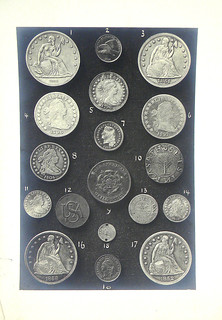
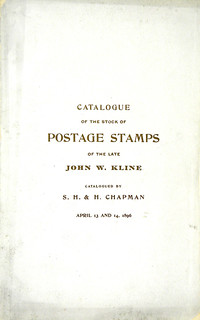
Lots 4 and 92
Lot 4: the extremely rare photographic plates issued for Geoffrey Charlton Adams's November 1906 Dixie Land Collection sale
Lot 92: S.H. and H. Chapman's April 13–14, 1896 catalogue of the John W. Kline collection, a stamp sale, but one of the true rarities of the Chapman series
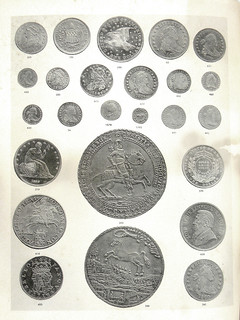
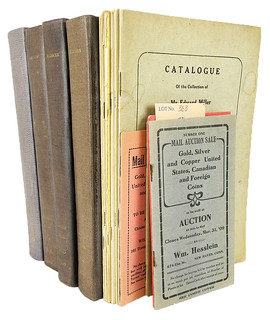
Lots 195 and 235
Lot 195: a rare plated copy of Tom Elder's October 14–15, 1907 sale, featuring material from the J.N.T. Levick collection, Elder's first plated catalogue
Lot 235: an exceptional collection of 49 different auction catalogues issued by William Hesslein, the most complete set we have ever offered
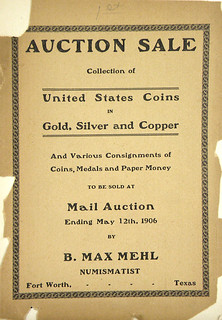
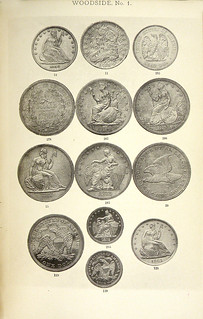
Lots 308 and 326
Lot 308: a complete set of B. Max Mehl's auction catalogues, 1906–1955
Lot 326: a remarkable bound volume including a fine plated copy of the New York Coin & Stamp Company's April 1892 George D. Woodside sale and Frossard's A.H. Saltmarsh sale, also with plates and held the same month
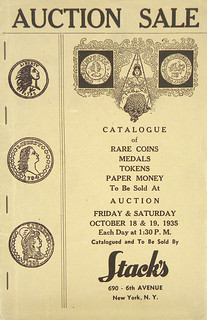
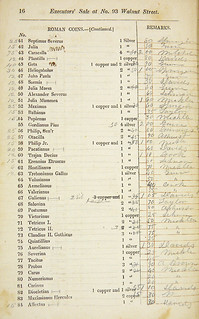
Lots 410 and 435
Lot 410: the most comprehensive set of Stack's catalogues we have ever offered, featuring over 900 catalogues from the firm's first offering in 1935 to earlier this year
Lot 435: Richard Wistar David's priced and named copy of the February 20, 1851 sale of the Dr. Lewis Roper collection, conducted in Philadelphia by M. Thomas & Sons, and considered the first significant coin sale held in the United States

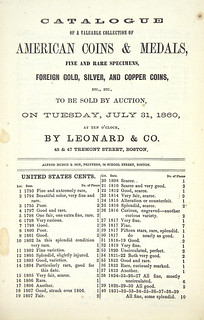
Lots 441 and 442
Lot 441: W. Elliot Woodward's very rare "A" sale, his first cataloguing effort, held on June 27–28, 1860 by Leonard & Co.
Lot 442: Woodward's extremely rare Sale 1 (July 31, 1860), the first solo copy we have offered since we sold this same copy in 1998.
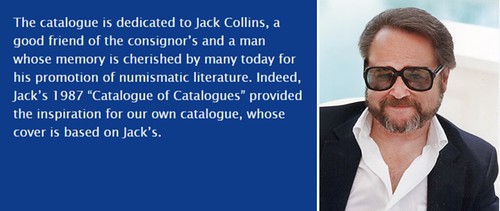
The printed catalogue has been mailed to active customers. A PDF of the printed catalogue has been posted to our main website at numislit.com for those who prefer that format. Bids placed via post, email, fax or phone must be received by Friday, Oct. 23, the day before the sale, in order for them to be processed. Advance absentee bids may also be placed at any time online at bid.numislit.com; live internet bidding will be available during the sale itself through the same platform.
Kolbe & Fanning Numismatic Booksellers LLC is a licensed and bonded auction firm in the State of Ohio. For more information, please see the Kolbe & Fanning website at bid.numislit.com or email David Fanning at df@numislit.com.
THE BOOK BAZARRE
NEW BOOK: CASH IN YOUR COINS, 4TH EDITION
Whitman Publishing has produced a new edition of Beth Deisher's Cash In Your Coins; here's the press release. -Editor
Cash In Your Coins: Selling the Rare Coins You've Inherited
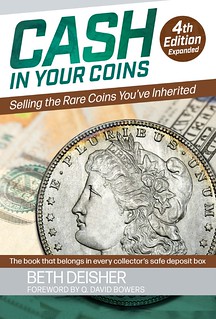 Whitman Publishing is releasing a larger, updated new edition of Beth Deisher's Cash In Your Coins: Selling the Rare Coins You've Inherited. The 336-page fourth edition will debut in October 2020. It will be available online (including at Whitman.com) and from booksellers and hobby shops nationwide for $19.95.
Whitman Publishing is releasing a larger, updated new edition of Beth Deisher's Cash In Your Coins: Selling the Rare Coins You've Inherited. The 336-page fourth edition will debut in October 2020. It will be available online (including at Whitman.com) and from booksellers and hobby shops nationwide for $19.95.
Cash In Your Coins tells readers who have inherited a numismatic collection how rare their coins are, how to value them, and how to sell or donate if they decide to liquidate all or part of an estate. Author Beth Deisher, an award-winning journalist and retired editor of Coin World, draws on more than 35 years of experience helping people understand and collect coins, paper currency, medals, and tokens.
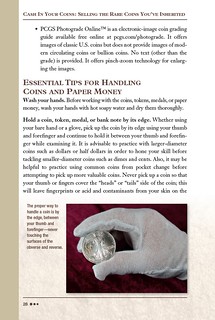
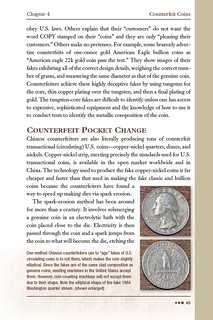
"I wrote Cash In Your Coins to inform and protect the millions of Americans who already collect coins, and those who will someday inherit their collections," Deisher said.
The revised fourth edition of Cash In Your Coins has 32 more pages than the third edition. New features include an in-depth illustrated chapter on the increasingly deceptive counterfeit coins emerging from China. This is an area of expertise for Deisher. After retiring from Coin World she served as director of anti-counterfeiting for the Anti-Counterfeiting Educational Foundation. The advice she shares is valuable for anyone unfamiliar with coins—and even for longtime hobbyists. This eye-opening chapter will help collectors' heirs identify risks and avoid mistakes.
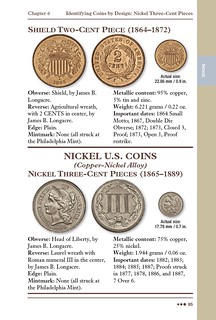
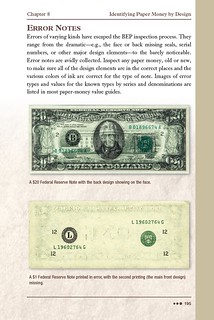
To help family members navigate the often-confusing world of inheritance, Deisher has updated the sections on state and federal taxes, trades, and exchanges. Current information is crucial in making wise decisions in declaring values, organizing tax-exempt charitable donations, figuring capital gains and losses, establishing trusts, reporting transactions, and similar activities. Many numismatists who have collected for decades are unfamiliar with the ins and outs of these topics. The chapters on appraisals and taxes should be read by hobbyists and their heirs alike.
Other guidance covers how to create an inventory, manage an independent appraisal, find a trustworthy coin dealer, communicate with potential buyers, and fairly divide a numismatic estate.
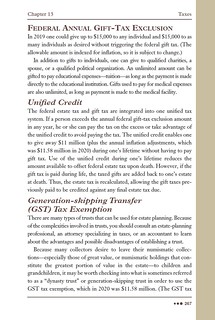
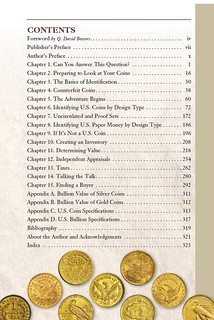
The book includes photographs and specifications of every U.S. coin type, including modern issues of the United States Mint; a bibliography for further research; and expanded bullion-value charts.
Whitman publisher Dennis Tucker said, "Since the beginning of 2020 we've seen evidence that more and more Americans are turning to popular classic hobbies like coin collecting. Demand for guide books and coin albums has increased. It's important for collectors to have a copy of Cash In Your Coins in their bank box or safe so their heirs can appreciate and benefit from their years of wise collecting."
Cash In Your Coins: Selling the Rare Coins You've Inherited, 4th edition
By Beth Deisher; foreword by Q. David Bowers
ISBN 0794848326
Softcover, 6 x 9 inches
336 pages
Full color
Retail $19.95 U.S.
For more information, or to order, see:
Cash In Your Coins, 4th Edition
(https://whitman.com/cash-in-your-coins-4th-edition/)
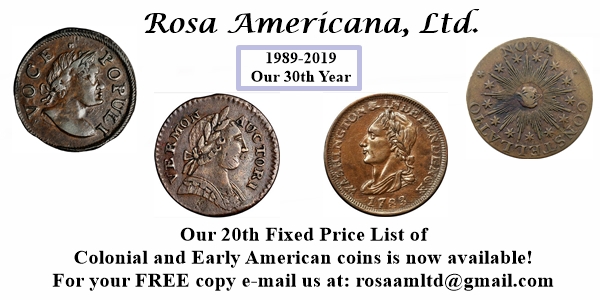
NEW BOOK: AUSTRALIANS AWARDED 2ND EDITION
Well, this one came out in 2014 but it's new to me and I don't think we've covered it before. Offered by Renniks, Australians Awarded covers honours, decorations, awards, medals and other official forms of recognition to Australians. -Editor
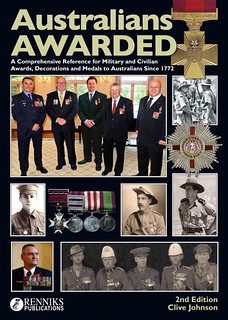 Australians Awarded 2nd Edition (Australian Medals, 780 pages, Full Colour)
Australians Awarded 2nd Edition (Australian Medals, 780 pages, Full Colour)
$49.95
This second edition is without question the most comprehensive reference of honours, decorations, awards, medals and official forms of recognition to Australians ever produced. Australians Awarded has been compiled over 15 years to create 800 pages of in – depth detail on Honours, Medals and Decorations to Australians from 1770 to 2013.
This edition includes comprehensive ribbon charts incorporating historical and current awards; detailed tables for types of awards; numbers issued, values, font types, medal types, ribbons, clasps, official badges, plaques, scrolls, certificates and detail for entitlement.
Australians Awarded II also includes the only comprehensive listing of foreign orders and decorations to Australians between 1850 and 2013, as well as the never before published state – by – state multi – jurisdictional internal forms of recognition and awards. All of this is studied and explained, with 1000's of images and extensive historical text. This book is for anyone with a passion for Australian military history, the enthusiast or specialist, the professional, the amateur, the collector, the dealer or simply anyone who has ever been, an Australian Awarded.
For more information, or to order, see:
Australians Awarded 2nd Edition (Australian Medals, 780 pages, Full Colour)
(https://renniks.com/shop/australians-awarded-2nd-edition/)
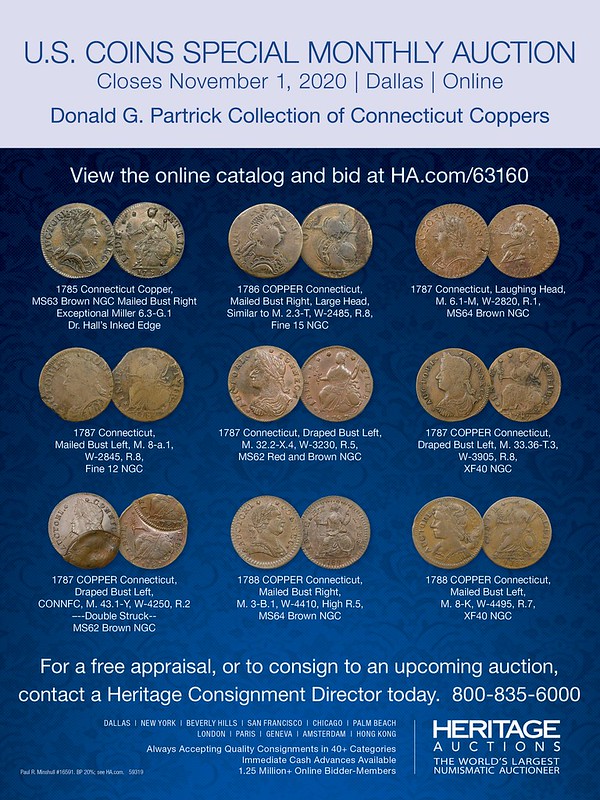
OPITZ ODD & CURIOUS AND TRADITIONAL MONEY ON NNP
Newman Numismatic Portal Project Coordinator Len Augsburger provided this reminder of an important reference work on NNP. -Editor
Charles Opitz Odd & Curious Reference Collection to be Sold
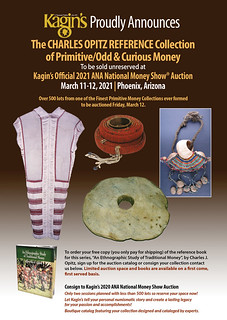 Kagin's has announced the sale of the Charles Opitz reference collection of odd and curious money, scheduled for the ANA National Money Show in Phoenix, AZ, on March 12. Odd and curious money encompasses just about anything outside of the familiar "form factors" of typical metal coins and paper money. Porpoise teeth, cardboard coins, woodpecker scalps, and hoe money are only a few of the hundreds of categories available to the collector of non-traditional forms of money.
Kagin's has announced the sale of the Charles Opitz reference collection of odd and curious money, scheduled for the ANA National Money Show in Phoenix, AZ, on March 12. Odd and curious money encompasses just about anything outside of the familiar "form factors" of typical metal coins and paper money. Porpoise teeth, cardboard coins, woodpecker scalps, and hoe money are only a few of the hundreds of categories available to the collector of non-traditional forms of money.
Charles Opitz's excellent guide to the subject is available on Newman Portal, and this massive 843-page compendium represents a lifetime of research on the subject. With multiple illustrations on nearly every page, this will be the definitive guide for the foreseeable future. For collectors with any interest in the subject, the Opitz sale will be an important opportunity to view and study these intriguing objects.
Link to Charles Opitz Odd & Curious and Traditional Money on Newman Portal:
https://nnp.wustl.edu/library/booksbyauthor/1482
VIDEO: GREATER TULSA COIN CONVENTION
These are selections from the David Lisot Video Library that feature news and personalities from the world of coin collecting. David has been attending coin conventions since 1972 and began videotaping in 1985. The Newman Numismatic Portal now lists all David's videos on their website at:
https://nnp.wustl.edu/library/multimediadetail/522852
Here's one with more on the Greater Tulsa Coin Convention. -Editor
Walkabout at the Greater Tulsa Coin Convention During the Covid Pandemic of 2020
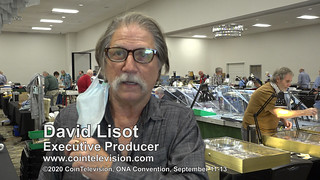 David Lisot, Host, CoinTelevision.com, Mike Boyer, Larry Camp, Steven Ellsworth, Chris Harrell, President, Jeff Nolen, Gary Parsons, & Dale Schaffer,
David Lisot, Host, CoinTelevision.com, Mike Boyer, Larry Camp, Steven Ellsworth, Chris Harrell, President, Jeff Nolen, Gary Parsons, & Dale Schaffer,
David Lisot travels to his first coin convention to do video after seven months from the beginning of the Corona Covid Pandemic. He wears a mask and interviews officials of the Oklahoma Numismatic Association, dealers, and ANA president. David finds out coin collecting is still alive and well!
An excerpt of the video is available for viewing on the Coin Television YouTube Channel at:
https://youtu.be/VFqoI9HTDhw
David Lisot writes:
"Some people adjusted their masks for the interviews where masks in Oklahoma were optional. We just shot video at the Denver Coin Expo with a whole new perspective where masks were mandated by law."
To read the earlier E-Sylum article, see:
VIDEO: GREATER TULSA SHOW BRAVES CORONAVIRUS
(https://www.coinbooks.org/v23/esylum_v23n39a11.html)
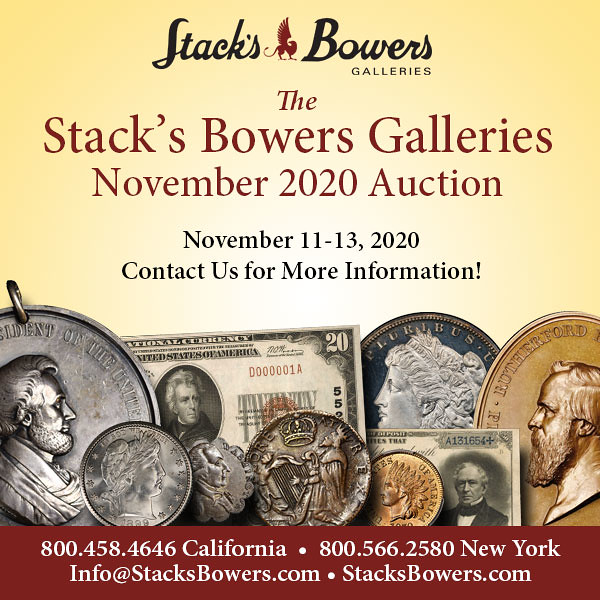
AUDIO: OXFORD'S EARLIEST COIN COLLECTIONS
The American Numismatic Society has published a new episode of their podcast, The Planchet. -Editor
Ep. 07: A Brief History of Oxford's Earliest Coin Collections
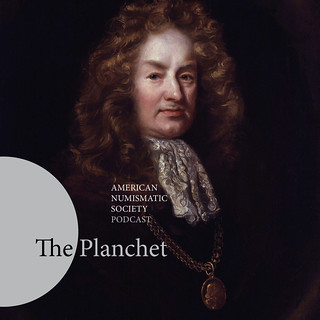 The Planchet, Season 1, Episode 7. An interview with Andrew Burnett (CBE, FSA, FBA), retired Deputy Director of the British Museum and Keeper of its Department of Coins and Medals, and co-author of Roman Coins, Money, and Society in Elizabethan England. Image: Elias Ashmole by an unknown artist, ca. 1688, after the portrait by John Riley.
The Planchet, Season 1, Episode 7. An interview with Andrew Burnett (CBE, FSA, FBA), retired Deputy Director of the British Museum and Keeper of its Department of Coins and Medals, and co-author of Roman Coins, Money, and Society in Elizabethan England. Image: Elias Ashmole by an unknown artist, ca. 1688, after the portrait by John Riley.
The seventh episode of The Planchet features an interview with Dr. Andrew Burnett, retired Deputy Director of the British Museum and its Keeper of Coins and Medals, who also presided over the Royal Numismatic Society from 2013–2018. Burnett discusses the origins of many of the earliest coin collections kept at Oxford (including those of the Bodleian Library and the Ashmolean Museum), the colorful personalities of 16th- and 17th-century collectors (esp. Elias Ashmole), plus a primer on early numismatic catalogues of public collections in Britain and what happens when a coin collection catches fire.
Purchase a copy of Roman Coins, Money, and Society in Elizabethan England here (for US readers) and here (for readers outside the US).
Total Time: 49 minutes
The Planchet is available wherever you get your podcasts
For more information, or to listen, see:
Ep. 07: A Brief History of Oxford's Earliest Coin Collections
(http://numismatics.org/planchet/01-07/)
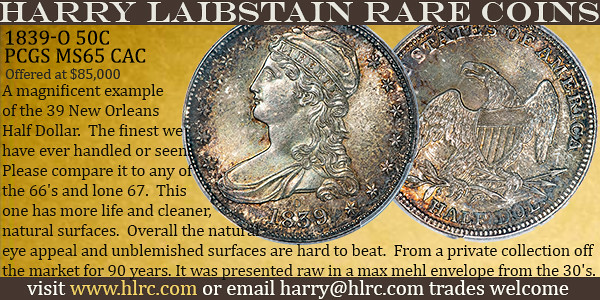
PCGS ANNOUNCES NFC TECHNOLOGY FOR SLABS
PCGS has announced the addition of Near Field Communication (NFC) technology in its products. I'm a little surprised that it's taken this long for any of the grading services to introduce something like this, but while it's an easy idea to consider, the devil is always in the details of implementation. This will greatly assist collectors and small and large dealers alike with keeping inventory, and as noted in the press release it will also help deter counterfeiting of slabs. -Editor
NFC Technology Included in all Holders
Professional Coin Grading Service leads numismatic hobby
with massive leap forward in anti-counterfeiting technology
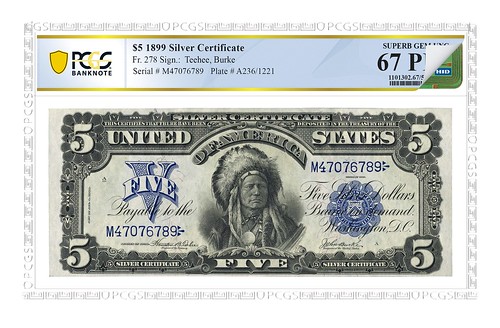
Professional Coin Grading Service (www.PCGS.com) has announced that it will begin embedding Near Field Communication (NFC) technology in all its encapsulated coins, medals, tokens, and banknotes in October 2020. This revolutionary advancement launches after an initial limited rollout earlier this year with coins graded in PCGS Gold Shield holders to test compatibility and user response, both of which were overwhelmingly positive.
"PCGS is the industry leader in fighting counterfeiting," says PCGS President Brett Charville. "PCGS has always been ahead of the curve in the numismatic industry regarding technology, and the inclusion of NFC technology is just the latest way we can stay one step ahead of counterfeiters and ensure collectors and dealers that their PCGS coins and banknotes are exactly what the label promises."
Adds Charville, "you collect, we protect."
PCGS, which in the spring became the first company in the numismatic industry to utilize NFC technology and remains the sole third-party grading service offering this technology, enables collectors to tap their holders with a phone, launching certification information right on the device's screen. This data ensure collectors, dealers, customers, and others that the coin or banknote stated on the label is indeed the piece inside the holder. The NFC technology has become necessary in a day and age when counterfeit coins and banknotes are more sophisticated than ever before. To combat this, PCGS partnered with HID Global to insert NFC technology in all holders, including PCGS Banknote holders, to provide peace of mind that collectibles within PCGS holders are 100% authentic and are in the grade or condition that is stated on the label.
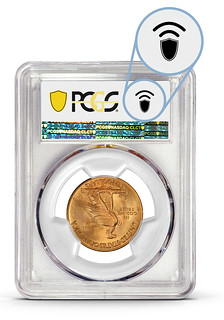 NFC inserts require no new hardware or any software updates. They are solid-state and
have no moving parts, do not contain any sort of battery, and will be encased in the
same industry-leading holder that keeps your coins and banknotes safe. Therefore,
without the risk of exposure to the elements and damage, expect these inserts to last
beyond the general expected lifespan of 100,000+ scans and 40+ years. That means a
collector scanning the NFC insert in any given PCGS holder can do so worry-free. NFC
technology works by exchanging encrypted technology between itself and another NFC-
enabled device, such as a smartphone.
NFC inserts require no new hardware or any software updates. They are solid-state and
have no moving parts, do not contain any sort of battery, and will be encased in the
same industry-leading holder that keeps your coins and banknotes safe. Therefore,
without the risk of exposure to the elements and damage, expect these inserts to last
beyond the general expected lifespan of 100,000+ scans and 40+ years. That means a
collector scanning the NFC insert in any given PCGS holder can do so worry-free. NFC
technology works by exchanging encrypted technology between itself and another NFC-
enabled device, such as a smartphone.
"This technology, similar to the chip found in the credit cards in your wallet, is the single biggest leap forward for third-party grading since its inception. While it may affect our pocketbook down the line, I would hope that every other third-party grading service in the industry considers integrating similar technology into their product lines as well. It's simply that important for the hobby as a whole," urges Charville.
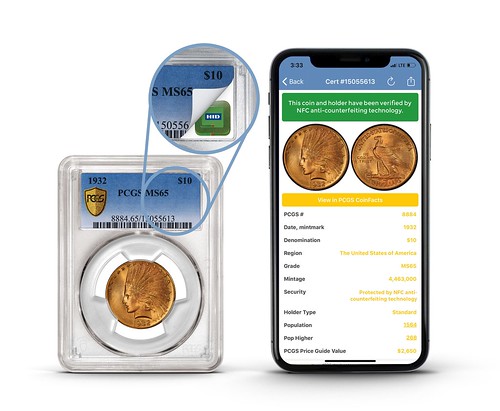
Those using an Android or iPhone XS (or newer) already have everything they need to benefit from PCGS's NFC technology upgrade. All they need to do is put those devices close to the chip, opening a web browser on the phone with information about the slab and coin or banknote within. The PCGS Cert Verification will automatically load on phones that have that app installed; the app can be installed for free by visiting https://www.pcgs.com/apps.
For more information about PCGS's NFC technology, please visit www.PCGS.com/security.

NOTES FROM E-SYLUM READERS: OCTOBER 4, 2020
More on Ed Leventhal
Tony Terranova writes:
"Ed Leventhal was a class act. I was in his shop once, on a road trip to Boston. A gentleman walked in and showed Ed a bust dollar in a lovely circulated grade. Ed asked the guy how much he wanted for it. The guy said a price, to which Ed replied "l can't pay you that much because you would be cheating yourself". He proceeded to offer 30-40% more than the guy wanted for it. That was Ed."
To read the earlier E-Sylum article, see:
JIM BISOGNANI REMEMBERS ED LEVENTHAL
(https://www.coinbooks.org/v23/esylum_v23n39a20.html)
Coin Show Mask Reminder
Regarding the video on last week's Greater Tulsa coin show,
Ken Berger writes:
"Everyone needs to remember to properly wear a mask! It should cover both a person's mouth & nose. Chris Harrell is wearing it incorrectly as he has it only covering his mouth. If he is encouraging people to wear a mask as he says, he should set a proper example."

Mike Marotta agrees. He writes:
"Chris Harrell does not have his nose covered. He is wearing his mask incorrectly and therefore ineffectively. I did not watch it at first, but I went back and viewed it. I captured half a dozen screenshots of people without masks. We will know soon enough if it was consequential."
Ken adds:
"I did watch the entire video. I noticed that although Chris wore his mask incorrectly, Gary Parsons wore it correctly & even conducted the interview with his mask on. Good for Gary!
"I'd estimate from the video that, at the most, only half of the people (dealers & customers) were wearing masks & I really didn't see any social distancing.
"I am glad I wasn't there. I miss the coin club meetings & shows very much but not enough to jeopardize my health (or possibly life) or that of my loved ones."
Planning and precautions mean little if people aren't following protocols. Every show will be different, but the uncertainty will keep a lot of people home for a long while. I've been pretty pleased with people in my area - proper mask-wearing is far more common. I steer far clear of the exceptions. -Editor
For more information, see:
Mask Etiquette and Care: What You Need to Know
(https://www.leehealth.org/health-and-wellness/healthy-news-blog/coronavirus-covid-19/mask-etiquette-and-care-what-you-need-to-know)
Len Augsburger pointed out a relevant comment from Gerry Fortin's blog from the Manchester, NH show this weekend. -Editor
"Commentary about Covid-19 precautions is warranted. I've never used so much hand sanitizer in my life! After every coin being shown or a completed purchase, I immediately squirted a shot of Purell as habit. Mask and glasses were always used.
What shocked me were several collectors wishing to shake my hand after a purchase. Where have these people been?"
To read the complete blog article, see:
October 3, 2020
The Coin Market is Back at Manchester NH Show!
(https://www.seateddimevarieties.com/DailyBlog.htm)
To read the earlier E-Sylum article, see:
VIDEO: GREATER TULSA SHOW BRAVES CORONAVIRUS
(https://www.coinbooks.org/v23/esylum_v23n39a11.html)
Altered Banknote Souvenirs
Readers Bob Leuver and Bob Bednar shared some of the correspondence this week on altered banknote souvenirs such as this colorized $2 bill. -Editor
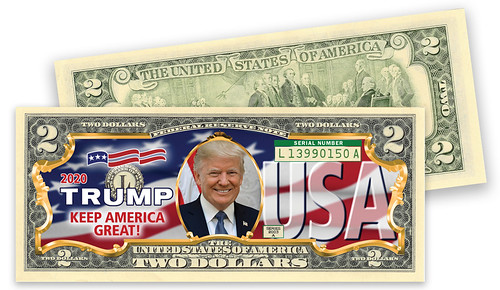
Keep your Collection Great with this brand-new Trump 2020 collectible!
A new election season is upon us, and what better way to honor our 45th President than with a brand-new Trump 2020 Colorized $2 Bill. No, this is not Fake News, but a tremendous opportunity for our collectors who appreciate President Trump. On the front, his official White House portrait image is transferred by us to the center oval of a genuine, authentic United States $2 Bill. Set against a backdrop of our beloved American Flag, one side of the bill is emblazoned with the 2020 date and his promise to Keep America Great! On the other side, a giant USA appears, a frequent chant of his supporters. No matter your political view, we're sure you'll agree this magnificent collectible is YUGE! Each comes complete with a deluxe display portfolio with Certificate of Authenticity. Don't wait, Get your Trump 2020 $2 bill today!
Bob Bednar writes:
"How can these guys do this with a $2 bill ? I bought one and it appears to be a clear printed poly Label on the face only."
Bob Leuver writes:
"I do not believe there is a law prohibiting the defacing of US currency or coins. There are many collector gambits."
Here's another one that leaves Jefferson alone. -Editor
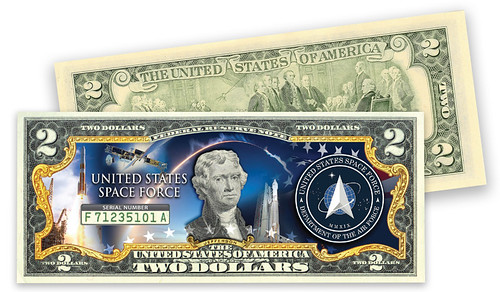
For more information, or to order, see:
Trump 2020 Colorized $2 Bill
(https://ncmint.com/trump-2020-colorized-2-bill/)
Space Force $2 Bill
(https://ncmint.com/space-force-2-bill/)
Rabbit Hole Coin Find in Gotland
Anne E. Bentley passed along this item about a hoard found in a rabbit hole in Gotland, Sweden. -Editor
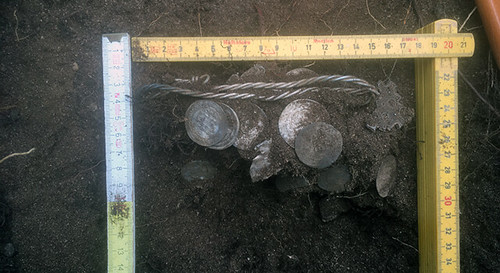
A 10th-century silver hoard has just been found on Gotland down a RABBIT HOLE. It contains dirhams and byzantine coins, plus a neckring and some other jewellery fragments.
To read the tweet, see:
https://twitter.com/catjarman/status/1312014721038594050?s=11
Documentary: The Booksellers
John Sallay writes:
"Readers may want to know about "The Booksellers", a documentary about the antiquarian book trade in New York. It was made in 2019 and released early this year, but it is now available on Amazon (free for Prime members). It's very well made and features many notable authors, dealers, and collectors.
The 2-minute trailer provides a nice overview, at:
https://www.youtube.com/watch?v=ymcRRt3Ix04
The New York Book Fair, Grolier Club, Argosy Book Store, Gutenberg Bible, the Fourth Avenue booksellers, the impact of the Internet, the aging of collectors and dealers, etc., etc., it's fascinating to watch. And the psychology – both dealers' and collectors' – will remind many of numismatics, not just numismatic books."
Thanks. Nice trailer. Check out the documentary. -Editor
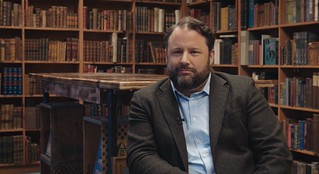 Antiquarian booksellers are part scholar, part detective and part businessperson, and their personalities and knowledge are as broad as the material they handle. They also play an underappreciated yet essential role in preserving history. The Booksellers takes viewers inside their small but fascinating world, populated by an assortment of obsessives, intellects, eccentrics and dreamers.
Antiquarian booksellers are part scholar, part detective and part businessperson, and their personalities and knowledge are as broad as the material they handle. They also play an underappreciated yet essential role in preserving history. The Booksellers takes viewers inside their small but fascinating world, populated by an assortment of obsessives, intellects, eccentrics and dreamers.
To watch the documentary, see:
The Booksellers
(https://www.amazon.com/Booksellers-Fran-Lebowitz/dp/B089CKVRVW/ref=sr_1_2)
CSNS Announces Virus Medal Design Contest
Gerry Tebben of the Central States Numismatic Society (CSNS) passed along this announcement of a new medal design contest. Thanks. Good luck, everyone! -Editor
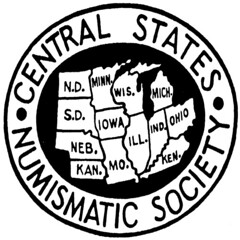 As the Corona virus ripped through the world this year, life changed
for us all, socially distancing us from our friends, family members and
fellow collectors. Coin shows everywhere were canceled, including our
own 81st anniversary convention.
As the Corona virus ripped through the world this year, life changed
for us all, socially distancing us from our friends, family members and
fellow collectors. Coin shows everywhere were canceled, including our
own 81st anniversary convention.
The medal will be distributed at the 82nd anniversary convention and will mark both the canceled 2020 convention and the hoped for 2021 show.
The society is conducting a contest, open to everyone, for the best design. The winner gets their initials on the medal and a specially struck silver medal with the serial number "000."
The deadline is Nov. 1, 2020 - just a few weeks away.
For more information, contact Gerry at gtebben@gmail.com . -Editor

SEEING STARS ON UNITED STATES COINAGE
Dave Lange writes:
"The 1891 letter from Director Leech to Superintendent Bosbyshell regarding five-pointed versus six-pointed stars reminded me of a two-part column I wrote years ago for The Numismatist. It took me awhile to find it at the NGC website, because the installments were published nonconsecutively."
Thanks! Here's an excerpt - see the complete articles online. I added a coin image from NGC Coin Explorer. -Editor
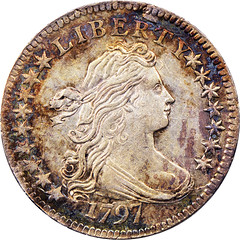
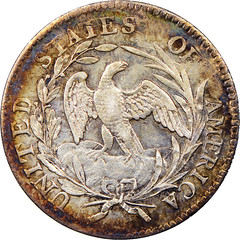
Count the stars...
Among the most common design elements on United States coins are stars. Many of the older USA coin types featured 13 stars, representative of the original states that declared their independence from Britain in 1776.
Of our current coin types, only the Kennedy half dollar still bears these 13 stars. They appear above the eagle in addition to a circle of 50 stars, both features being components of the presidential seal depicted on the half dollar's reverse. If one considers the Anthony dollar to be a current type (I still get them in change from the post office once in awhile), then it too bears an arc of 13 stars on its obverse. The Roosevelt dime has no stars, while the Jefferson nickel has but one, which is used as a "stop" for the legends. The Lincoln cent likewise does not include stars in its design, though Frank Gasparro's original model for the Memorial reverse of 1959 bore 13 stars (these were removed at the direction of the Treasury secretary to achieve a less cluttered look). The current state quarter series include among its entries many designs having various numbers of stars, these having either national or local significance.
The first coins issued by the USA were the Fugio cents. Dated 1787, numerous varieties were produced, yet the only star that appeared on most of these was our sun, shown in the ancient fashion as having a face. A single variety of the Fugio series features eight-pointed stars on a garter, but these were used solely as stops between the words STATES and UNITED. Among the 1792-dated pattern coins of the infant U.S. Mint, only the half dimes bore a star—a single, five-pointed star which, in the traditional language of heraldry, is known as a mullet. Strictly speaking, in heraldry only the six-pointed depiction may be called a star, yet both variants have been used interchangeably on United States coinage. In American numismatics the mullet is sometimes referred to as an American star, while the six-pointed version is described as an English star, but I've not been able to find any definitive source for such usage.
The so-called English star predominates on 18th and 19th Century United States coins, but it gave way to the American star for most 20th Century issues. Charles Barber's quarter dollar and half dollar of 1892 appear to have been transitional, as they feature six-pointed stars on the obverse and five-pointed ones on the reverse. Barber himself was English-born, but it's doubtful that this played any role in his decision. Fellow U.S. Mint Engraver George Morgan was likewise an Englishman, yet he utilized six-pointed stars for both sides of his 1878 silver dollar.
The first mass-produced coins of the U.S. Mint to display stars as a regular feature of their designs were the silver dollars, half dollars and half dimes of 1794. These bore 15 stars around the bust of Liberty, representing the number of states in the Union at that time. This number was carried over from the first cents of 1793, which featured 15 interlocking chain links. As Tennessee was admitted to the Union in 1796, newly prepared dies for the silver and gold coins included 16 stars. This resulted in a somewhat crowded appearance, and it was decided a short time later that only the original 13 states could be honored in this fashion. An example of how rapidly this transition occurred may be seen in the half dimes dated 1797. These come with alternately 15, 16 or 13 stars, the dies having been prepared in that order.
To read the complete articles, see:
Seeing Stars
(https://www.ngccoin.com/news/article/638/)
Seeing Stars: Part Two
(https://www.ngccoin.com/news/article/627/)
To read about the 16-star 1797 dime, see:
EARLY DIMES
1797 16 STARS JR-1 10C MS
(https://www.ngccoin.com/coin-explorer/early-dimes-1796-1837-pscid-28/1797-16-stars-10c-jr-1-ms-coinid-816458)
To read the earlier E-Sylum article, see:
FIVE AND SIX POINT STARS ON BARBER COINAGE
(https://www.coinbooks.org/v23/esylum_v23n39a10.html)

AMERICAN BANK NOTE COMPANY PARAGUAY ALBUM
At my request book dealer Gil Parsons kindly provided this excerpt from the anniversary catalog of his firm Parsons Books. It describes an American Bank Note Company album of Paraguay banknote specimens and proofs. What a treasure! -Editor
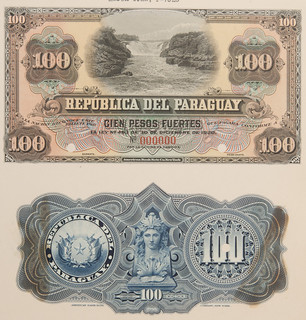 AMERICAN BANK NOTE COMPANY
AMERICAN BANK NOTE COMPANY
Album of 101 banknote specimens and proofs, representing the entire range of the company's production on behalf
of banks in Paraguay from 1882 through 1940; bank notes
mounted on loose manila office binder sheets, with typed
production notes.
Most banknotes in exceptional condition, some with minor evidence of staining caused by adhesive bleed through.
By the early twentieth century the American Bank Note Company had become the largest producer of bank notes in the world, producing currency for a large number of countries. When the company sought to organize its records and archives, each country was given a file, and each file ended up in mundane office binders organized alphabetically. Thus Paraguay comprised a small part of the binder "P", a relatively minor bit of real estate on an entire wall of records.
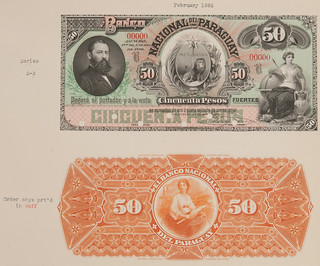 When the American Bank Note Company dispersed its
archives (a process which began in the 1970s and continued
for over twenty-five years—Christies' catalogues of the first
of these sales being themselves now scarce and valuable
reference works), virtually all of the country binders were
split up, with collectors vying for examples of notes which
were, in many cases and as here, to be found nowhere else.
The Paraguay album at hand is, to the best of our knowledge,
the only country album from the company to remain intact,
a happy accident caused by its having been bundled into a
plain envelope after its initial purchase and subsequently
forgotten for many years until rediscovered by chance as
part of a bulk transaction.
When the American Bank Note Company dispersed its
archives (a process which began in the 1970s and continued
for over twenty-five years—Christies' catalogues of the first
of these sales being themselves now scarce and valuable
reference works), virtually all of the country binders were
split up, with collectors vying for examples of notes which
were, in many cases and as here, to be found nowhere else.
The Paraguay album at hand is, to the best of our knowledge,
the only country album from the company to remain intact,
a happy accident caused by its having been bundled into a
plain envelope after its initial purchase and subsequently
forgotten for many years until rediscovered by chance as
part of a bulk transaction.
In many parts of the world, and in Latin America in particular, bank note companies American and European vied intensely for production contracts. In Paraguay, the American Bank Note Company gained inroads atop a wave of pro-American sentiment. Paraguay is likely the only place in the world where President Rutherford B Hayes is remembered fondly (or perhaps even at all)—Hayes (pronounced AH-jes) is commemorated in Paraguay by monuments, avenues and plazas as a result of his adjudication of a border dispute in Paraguay's favor.
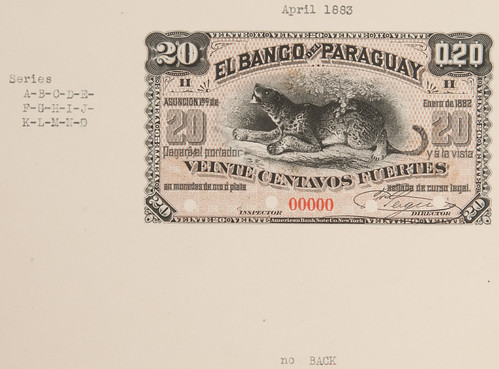
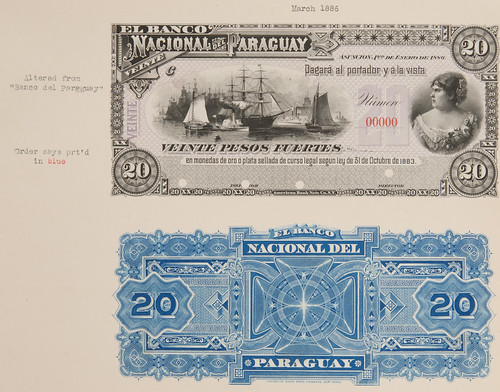
That the result of the initial agreements was felicitous can readily be seen from the album at hand, and the American Bank Note Company was able to place Paraguayan currency on a solid (and occasionally magnificent) artistic footing. Paraguayan currency in its infancy (in the 1850s) had been fairly simple in design, with only occasional woodcuts as graphic elements amidst functional and largely inelegant typography. But, the rapid growth of a modern economy necessitated modern (and secure) currency, which factors of civic and banking pride augmented—
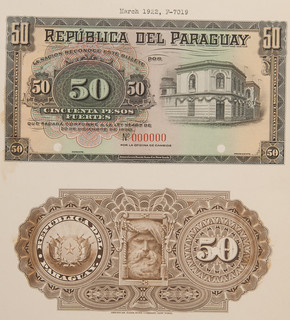
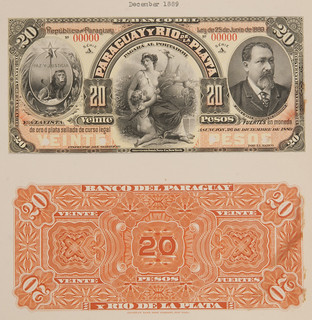
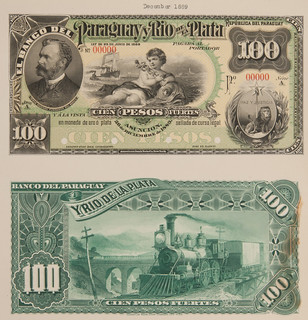
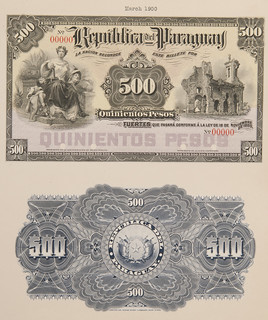
Paraguay got some of the very best engraving which the American Bank Note Company was able to offer— portraits, scenic vignettes, exquisite and exuberant lathe work, the most fashionable of typography and design, striking tints and even dramatic rainbow printing. Taken as an ensemble, the result is remarkable. and a graphic reminder of how far standards have fallen.
See particularly: Griffiths, William The Story of the American Bank Note Company New York 1959
Pratt Mayans, Miguel Angel and Pusineri Scala, Carlos Alberto Billetes de Paraguay Asuncion 1990
And for general context:
Fernandez, Pedro Analisis de la Historia Bancaria y
Monetaria del Paraguay Asuncion 1982/1984
This great item has already been sold, but for more information on other numismatic literature in his inventory, contact Gil Parsons at parsonsb@sonic.net. -Editor
To view a photo album with more images on our Flickr archive, see:
ABNCO Paraguay Album
(https://www.flickr.com/photos/coinbooks/albums/72157716233737503)

VOCABULARY TERM: NARRATIVE RELIEF
Dick Johnson submitted this entry from his Encyclopedia of Coin and Medal Terminology. Thanks. -Editor
Narrative Relief. The use of multiple figures and scenes of events in continuous sequence. Narrative relief, also called continuous relief, is much like a comic strip without panes. In medallic form narrative relief is called a register which employs multiple ground lines with the multiple designs crossing over a ground line or two.
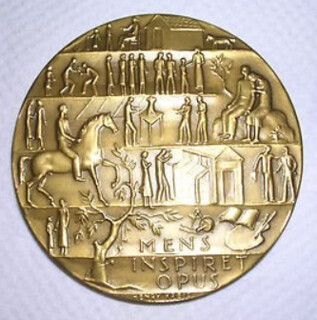 As an art technique the use of narrative relief is quite old. First used in Egyptian wall relief sculpture which presented human, animal and mythical figures in noteworthy scenes. The most famous narrative relief is Trajan's Column with a spiral base line winding up a 125-foot column with a 4-foot band over 625 feet long. The marble column is hollow with a staircase inside; it was built 106-113 AD to be the tomb of Roman emperor Trajan. The continuous relief tells of two campaigns during Trajan's reign. It is still standing but the relief has been eroded by time. A statue of Saint Peter was added at a later time.
As an art technique the use of narrative relief is quite old. First used in Egyptian wall relief sculpture which presented human, animal and mythical figures in noteworthy scenes. The most famous narrative relief is Trajan's Column with a spiral base line winding up a 125-foot column with a 4-foot band over 625 feet long. The marble column is hollow with a staircase inside; it was built 106-113 AD to be the tomb of Roman emperor Trajan. The continuous relief tells of two campaigns during Trajan's reign. It is still standing but the relief has been eroded by time. A statue of Saint Peter was added at a later time.
An excellent example of narrative relief is illustrated: the Hartford Art School Medal of 1952 by Henry Kreis. See register.
Looking for the meaning of a numismatic word, or the description of a term? Try the Newman Numismatic Portal's Numismatic Dictionary at: https://nnp.wustl.edu/library/dictionary
Or if you would like a printed copy of the complete Encyclopedia, it is available. There are 1,854 terms, on 678 pages, in The Encyclopedia of Coin and Medal Technology. Even running two a week would require more than 19 years to publish them all. If you would like an advance draft of this vital reference work it may be obtained from the author for your check of $50 sent postpaid. Dick Johnson, 139 Thompson Drive, Torrington, CT 06790.
CHARLES "CLARKE" ELLSWORTH GILHOUSEN (1869-1952)
John Lupia submitted the following information from the online draft of his book of numismatic biographies for this week's installment of his series. Thanks! As always, this is an excerpt with the full article and bibliography available online. This week's subject is collector C. E. Gilhousen. -Editor
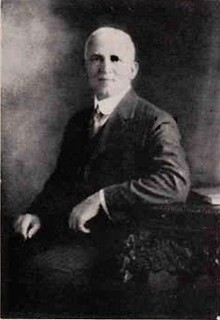 C. E. Gilhousen is famous for his outstanding gold coin collection. He was a photographer, real estate agent, miner, and auto dealer who amassed one of the most prestigious collections in American numismatic history.
C. E. Gilhousen is famous for his outstanding gold coin collection. He was a photographer, real estate agent, miner, and auto dealer who amassed one of the most prestigious collections in American numismatic history.
Charles "Clarke" Ellsworth Gilhousen (1869-1952), was born on December 13, 1869, Kahoka, Clark, Missouri, son of William Henry Gilhousen (1841-1932), and Sarah Ellen Clarke Gilhousen (1843-1938).
He was educated at The Dalles, Oregon.
Gilhousen worked as a professional photographer until 1899.
On June 1, 1892, he married Laura "Lulu" Pollock (1873-1918), at Kahoka, Clark, Missouri. They had a son Howard "Holly" Clarke Gilhousen (1895-1969).
In 1900, he lived in Warsaw, Hancock County, Illinois.
In 1901, the Los Angeles City Directory lists him living at 1031 East 27th Street. He was in the real-estate firm of Jordan & Gilhousen 2603 Central Avenue, having formed a partnership with Paul Jordan.
Gilhousen began to expand the real estate business to include mining.
In 1905 Gilhousen bought out Jordan and renamed the company C. E. Gilhousen & Co.
The 1905 -1910 Los Angeles City Directory on page 2241 lists him at 2603 South Central Avenue under Notaries Public.
In 1910, he entered the automobile business trading as Gilhousen Bros. Co.
In 1918 he married Jeanette S. Duckett Amsbary (1868-1962), at Los Angeles, California.
He was a member of the California Coin Club, and became president.
The 1930 U. S. Census lists him as a gold miner dredging for gold.
From February 19-21, 1973, Superior Stamp and Coin auctioned Part 1 of the Gilhousen Collection realizing $875,000.
From June 11-14, 1973, Superior Stamp and Coin auctioned Part 2 of the Gilhousen Collection realizing $840,000.
From October 1-4, 1973, Superior Stamp and Coin auctioned Part 3.
To read the complete article, see:
GILHOUSEN, CHARLES ELLSWORTH
(http://www.numismaticmall.com/numismaticmall-com/gilhousen-charles-ellsworth)

WILSON DOLLAR CENTENNIAL MEDALS
Jeff Shevlin is offering a great-looking restrike of the "Wilson Dollar" medal. Here's the press release. -Editor
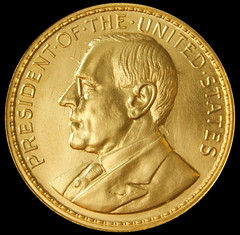
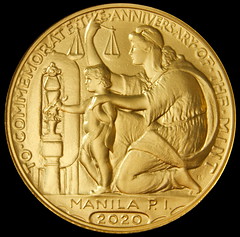
Wilson Dollar 100-year Anniversary medal in Gold
This year, to commemorate the 100-year anniversary of the Manila Mint, restrikes of the Wilson Dollar are being offered for sale. The restrikes have been struck using the original Wilson Dollar obverse die engraved by George Morgan.
The Wilson Dollar was originally struck on the newly installed minting equipment in the Philippines, the only overseas U.S. Branch Mint, to commemorate the opening of the Manila Mint in 1920. They were struck in gold, silver and bronze.
George Morgan, who engraved the dies for the Morgan dollar, also engraved the dies for the Wilson dollar.
Jeff Shevlin, the So-Called Guy, a nationally recognized expert on So-Called Dollars, historical U.S. medals, is offering the restrikes, struck by Daniel Carr of the Moonlight Mint, in gold, silver, copper, brass, aluminum, nickel and select gold-plated. The restrikes are 38mm, the same size as the original. The gold is 1.6oz, 50 grams of gold and edge marked "50 GRAMS 999+ GOLD" is $5,000. The silver is edge marked "ONE TROY OUNCE .999 SILVER" is $100. The copper is $50, and the brass, aluminum and nickel are
$35. Silver with select gold-plate is $125. The obverse die is the original Wilson Dollar die engraved by George Morgan. The reverse die commemorates the 100 th anniversary of the Manila Mint and will be almost identical to the original die except in the legend "ANNIVERSARY" replaces "OPENING" and will be dated 2020. A custom Lucite holder to display the gold, silver and copper is free when the set of three are purchased. A custom Lucite holder for the silver, silver select gold-plate, copper, brass, aluminum, and nickel is free when the set of six are purchased.
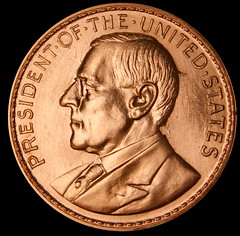
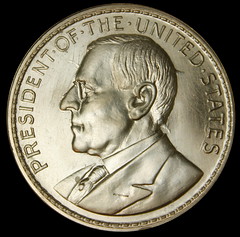
Copper and Silver
Dennis Tucker, publisher, Whitman Publishing, said regarding the 100 Year Wilson Dollar Anniversary restrikes by Jeff Shevlin, "The Wilson Dollar is one of the most historically significant issues among the medals numismatists identify as ‘So-Called Dollars.' We value it for the unique way it connects the people of the United States to the people of the Philippines—a golden (and silver and bronze!) symbol of a deeply important connection that resonates to this day." "In Whitman's Mega Red, the expanded edition of the Red Book, we devote more than a page and a half to the Wilson Dollar. This is a measure of the importance of this intriguing, richly layered, and many-storied medal."
The Manila Mint was destroyed during World War II when the Japanese invaded the Philippine Inlands and almost 10 million dollars' worth of silver pesos, as well as Wilson dollars, were dumped into Manila Bay to avoid capture by the Japanese.
It was reported that five Wilson Dollars were struck in gold, but seven are accounted for today, 2,200 were struck in silver and 3,700 in bronze.
Visit the website www.WilsonDollar.com to place your order or contact Jeff Shevlin at SoCalledGuy@hotmail.com or (916) 955-2569.
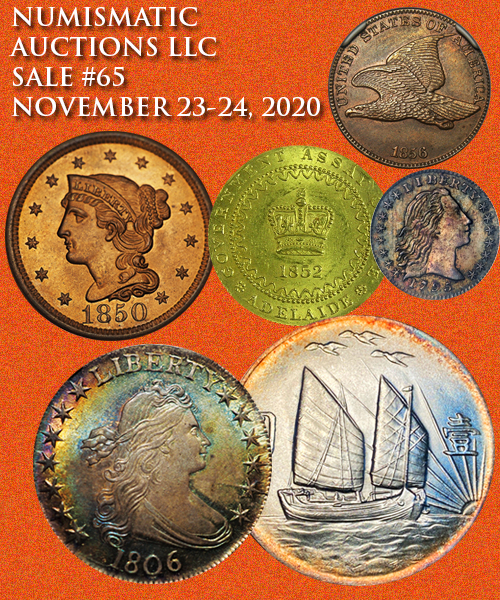
ANA MONEY MUSEUM REOPENS TO PUBLIC
The American Numismatic Association has reopened their museum to the public. Here's the press release. -Editor
New Guidelines Encourage Public Safety Amid COVID-19 Concerns
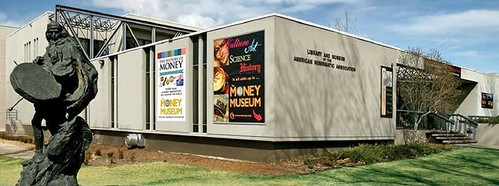
The Money Museum in Colorado Springs has reopened to the public after being closed for nearly six months due to the COVID-19 pandemic. The museum is open on a revised schedule with limited days and hours – Wednesdays through Fridays from 11 a.m. to 3 p.m.
To remain in compliance with restrictions mandated by the state of Colorado, to protect museum staff and patrons, the museum has implemented the following guidelines:
- No more than 25 visitors in the museum at a time.
- Masks are required for safety.
- Social distancing rules will be observed; guests are requested to maintain a 6-foot distance from other visitors (with the exception of family groups).
- Contact with cases and other surfaces within the museum should be minimized.
- No more than six people in the Harry W. Bass Jr. Gallery at one time.
- No more than three individuals (or up to six if part of a group) in the theater at one time.
The Money Museum is the largest museum in the U.S. dedicated to numismatics. The museum explores art, history, science and culture to promote the diverse nature of money and related items.
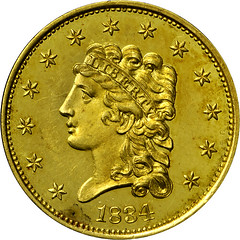 Visitors can find spectacular rarities in its three main galleries and learn about the history of our nation and the world as seen through money. The main exhibit, "Money of Empire: Elizabeth to Elizabeth" uses money and medals to illustrate the development of the British Empire from its beginnings under Elizabeth I to the present day.
Visitors can find spectacular rarities in its three main galleries and learn about the history of our nation and the world as seen through money. The main exhibit, "Money of Empire: Elizabeth to Elizabeth" uses money and medals to illustrate the development of the British Empire from its beginnings under Elizabeth I to the present day.
Also on display is the Harry W. Bass Jr. Gallery, one of the most complete U.S. gold coin collections ever assembled; and "The History of Money," which maps out the evolution of money from its invention to the modern day.
The Money Museum is located at 818 N. Cascade Ave., adjacent to the campus of Colorado College and next door to the Colorado Springs Fine Arts Center. Current museum hours of operation are Wednesday through Friday, 11 a.m. to 3 p.m. Regular admission is $8 ($6 for seniors and students). Kids 12 and under are always free. Guided tours of the museum are available by reservation only. For more information, call (719) 632-2646 or visit money.org/money-museum.
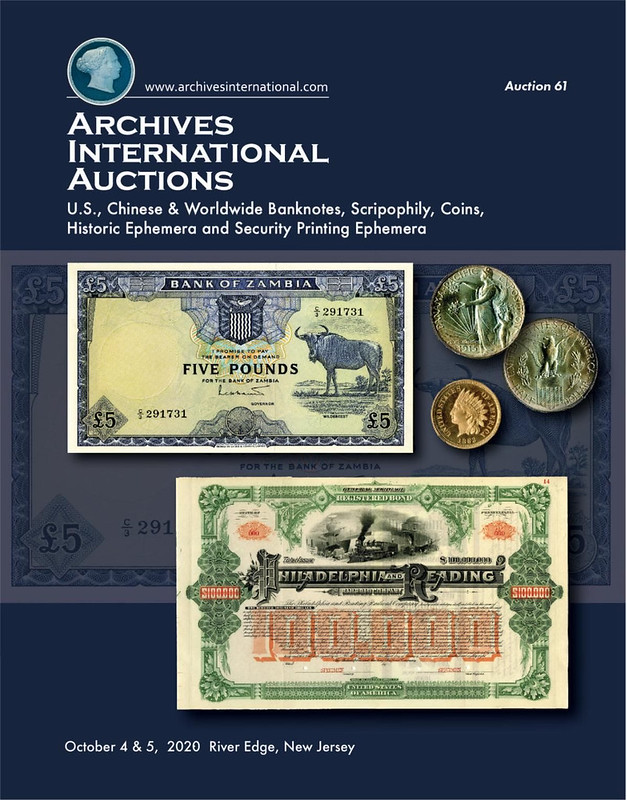
2020 ANA AWARDS
The American Numismatic Association announced its 2020 award winners in virtual programs in September. Here's the announcement. Your truly received one, as did Maria Fanning, editor of our wonderful print journal, The Asylum. Congratulations to all. -Editor

Leaders in numismatics are essential for helping others to grow within the hobby. Whether that leadership is provided through teaching, mentoring, research, writing or leading conventions and shows, these activities help foster learning for all collectors. The American Numismatic Association's (ANA) biggest influencers were recognized during two virtual awards programs on Sept. 1 and 2.
Mentors who ensure the growth of the hobby by encouraging and guiding the next generation of numismatists are honored with the Lawrence J. Gentile Sr. Memorial Award for Outstanding Adult Advisor. This year the award went to Brian Fanton of Hiawatha, Iowa, during the Sept. 1 award ceremony. Fanton is actively involved in several local and regional numismatic organizations, including the Hiawatha Coin Club (which he founded in 2004), the Waterloo-Cedar Falls Coin Club, the Iowa Numismatic Association and the Central States Numismatic Society.
This experienced hobbyist is happy to share his knowledge, accumulated over nearly six decades of collecting, with eager youngsters. Fanton conducts Boy and Girl Scout Coin Collecting Merit Badge workshops in his home state, and also donates supplies to Scout classes nationwide. Additionally, the U.S. Navy veteran travels to elementary schools to give talks to thousands of children. He also welcomes youth to his shop, BE's Coins & More, where he shares the allure of numismatics and offers a "smile discount" at the register.
Fanton has been a life member of the ANA since 1989, and in that time he has won an assortment of accolades, including a Presidential Award (1998), Adna G. Wilde Jr. Memorial Award for Excellence (2012) and Farran Zerbe Memorial Award for Distinguished Service (2017). He has served on the Education Committee for 16 years and as an ANA District Representative for more than 20 years.
Each year since 1971, the American Numismatic Association has recognized the best journals and newsletters produced by ANA-member organizations. Entries in this year's Barbara J. Gregory Outstanding Club Publications competition were recognized for excellence on Sept. 1 and were judged in four categories: regional, local, specialty and electronic.
Regional Clubs:
- Third – The Clarion, Pennsylvania Association of Numismatists (Richard Jewell, editor)
- Second – TNA News, Texas Numismatic Association (Ann Marie Avants, editor)
- First – The MichMatist, Michigan State Numismatic Society (Michael Strub, editor)
Local Clubs:
- Third – Stephen James CSRA Coin Club Newsletter, Stephen James CSRA Coin Club (Arno Safran, editor)
- Second – SVCC Newsletter, Sacramento Valley Coin Club (Patrick Carpenter, editor)
- First – Pocket Change, Albuquerque Coin Club (Phil Vitale, editor)
Specialty Clubs:
- Third – ErrorScope, CONECA (Allan Anderson, editor)
- Second – International Bank Note Society Journal, International Bank Note Society (Alexander Kort, editor)
- First – The Asylum, Numismatic Bibliomania Society (Maria Fanning, editor)
Electronic Newsletters:
- Third – Double Shift, Greater Houston Coin Club (John Barber, editor)
- Second – The Mint Master, Utah Numismatic Society (Douglas Nyholm, editor)
- First – The SCanner, South Carolina Numismatic Association (Stephen Kuhl, editor)
The spirit of the late Glenn Smedley lives on in this year's recipients of the ANA's annual Glenn Smedley Memorial Award, which were recognized Sept. 2, during the Service Awards. Five members who embody an exceptionally positive attitude, possess strong communication skills, promote goodwill and cooperation, and demonstrate dependability were honored.
• Eve Barber of The Woodlands, Texas, has actively participated in the Greater Houston Coin Club since 1994. She maintains an active database of more than 800 student participants in the group's Coins for A's program. Her collecting interests include horse pesos of Mexico and the puffin coinage of Lundy Island. She has exhibited on both of these topics at local and regional shows. Barber received the Greater Houston Coin Club's Townsend Award in 2010.
• Cindy Calhoun is a well-known figure in The Elongated Collectors (TEC) and has led the organization as president since 2017. Noting the difficulty of acquiring new elongates, Calhoun has placed more than 30 nonportable elongate machines at tourist attractions across the United States and has designed more than 400 rolling dies. A certified ANA exhibit judge, Calhoun has shown eight competitive displays at the last six World's Fair of Money® conventions. She also is a welcome fixture at ANA conventions, where she has manned the TEC club for many years.
• Wayne Homren has served in multiple offices in many local, regional and national organizations. Homren is willing to pitch in wherever he is needed, whether that means leading an organization or providing grunt work on a project. He's well-known in the numismatic community for launching in 1998 The E-Sylum, a weekly newsletter for members of the Numismatic Bibliomania Society. Homren serves as editor to this day, and has had a hand in publishing more than 25,000 articles since the newsletter's inception.
• Bob Jones, ANA life member and a U.S. Navy veteran, has served the Association as a District Representative for Kentucky since 2009 and is vice president of the Bluegrass Coin Club (2016-present). A knowledgeable collector, Jones completed the ANA's Numismatic Diploma Program in 2010. He has taught more than a dozen courses at the ANA Summer Seminar since 2008.
• David Menchell has twice lectured on the topic of medals at the annual Coinage of the Americas Conference and has taught courses on medals at the Association's Summer Seminar. In 2017 Menchell donated more than 500 medals to the ANA Edward C. Rochette Money Museum for use in educational courses. He's also published many well-researched articles on 17th- and 18th-century tokens and medals. Menchell has served as an ANA District Representative for New York City for the last 15 years. He's also a certified ANA exhibit judge.
To watch the ceremonies, see:
https://info.money.org/awards-2020
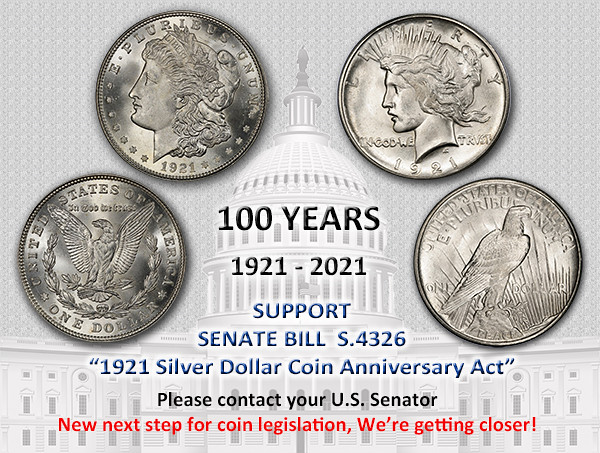
THE MAURICE STORCK COLLECTION
This month Heritage is offering the collection of Farouk auction attendee Maurice Storck. Here's an article from their September 29, 2020 Coin News email newsletter. E-Sylum gets a mention. -Editor
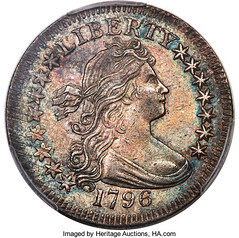
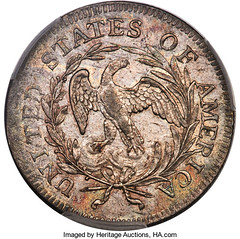
1796 Draped Bust Quarter
The Maurice Storck Collection, to be offered October 14-17, ranks among some of the freshest offerings Heritage has ever brought to auction. His World Coins and Currency were auctioned in August and realized huge premiums for their certified grades. His U.S. coin collection spans the spectrum - with many of the coins being off the market for decades - including a large group of coins that were last offered publicly as part of the famous King Farouk auction in 1954!
Maurice A. Storck Sr. was born on May 20, 1922. He grew up in Portland, Maine, where his formative years were strongly influenced by the Great Depression. Maurice worked several jobs to help support the family - all of which helped him cultivate a lifelong work ethic and a seemingly endless enthusiasm for the task at hand. He sold newspapers as a boy - a time when he perceptively discovered stamps and coins in the local shop. His future career as a coin dealer and numismatist had its roots in grammar school and later school years, when he was known to deal coins and stamps to friends and associates. He attended local schools until he was 14 years old, then enlisted full time in the Maine National Guard.
Throughout his years in the military, Maurice honed his talent for buying, trading, acquiring, and selling. He was known as someone who could find anything and get things done. He was also a dedicated soldier, who did not shy from battle or avoid conflict. He met his future wife, Nancy, in New Zealand during the war.
Along the way, he became a seasoned world traveler thanks to his military years. After the war, Maurice put the same enthusiasm and willingness to travel into his stamp and coin business, which he started soon after his medical discharge from the army. The Storck name became well-known throughout Maine and New England. His expertise centered around early gold, silver, and type coins, but he had interest in all things numismatic. He joined the American Numismatic Association in 1948 and took particular pride in being the first person to pay $100 for an ANA life membership.
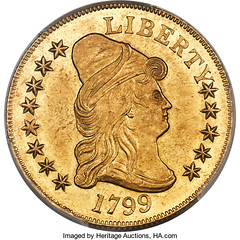
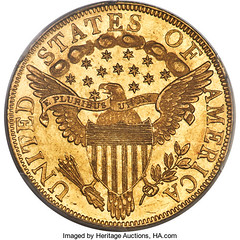
1799 Eagle
By 1951, Storck was traveling internationally to purchase coins. His trip to Cairo, Egypt in 1954 was a highlight of his numismatic career, when he was one of the few American coin dealers and collectors to attend the coin and medal segment of The Palace Collections of Egypt auction, commonly known as The King Farouk Sale. Between February 24 to March 6, 1954, Maurice Storck bid against (and with) such luminaries as Abe Kosoff, Ambassador and Mrs. Henry Norweb, John J. Pittman, James P. Randall, Hans M.F. Schulman, Robert Schermerhorn, and a few others.
The Storck purchases in Egypt included interesting group lots and important gold coins, some of which were sold over the years, and others that remained in his private collection. Numerous coins with confirmed King Farouk pedigrees appear here, offered as part of The Maurice Storck Collection.
In 1960, Storck opened a stamp and coin store in Portland that was soon the largest in the state. He contributed to the 1960 Red Book and later to the 1964 Blue Book. Ken Bressett hired Storck to become a distributor for Whitman Publishing Company's (now Western Publishing Co.) coin supplies.
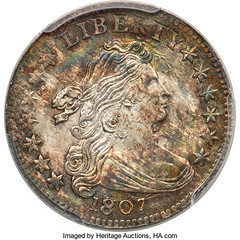
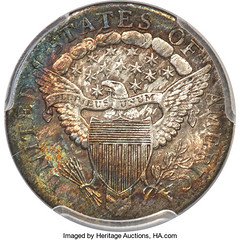
1807 Draped Bust Dime
In 1970, Maurice sold his coin business and "retired." He and Nancy traveled all throughout the United States in their motorhome for several years. They settled in Tucson, Arizona and spent summers in Maine until Nancy passed away in 1990. Maurice became a year-round resident of Arizona, donating his time and money at the Veteran's Administration, where he logged over 54,000 volunteer hours. He served as president of the Veterans Stamp and Coin Outreach Program, a volunteer organization that distributed philatelic and numismatic material to veterans and shut-ins throughout the country.
Maurice A. Storck passed away peacefully on November 29, 2019 at the Arizona State Veterans Home in Tucson. He was a life member of the Portland Club as well as the ANA. He was a 32nd degree Mason, a member of the 25th Infantry Association, and a life member of the Tucson Coin and Stamp Clubs. He collected Masonic Chapter pennies, reportedly amassing a collection of 15,000 of them. He was a decorated veteran who received several medals, including a Purple Heart. Maurice Storck was buried at Arlington National Cemetery in Washington, DC with full military honors.
In 2017, Alan V. Weinberg nominated Mr. Storck as the oldest living U.S. coin dealer, and Maurice was a featured in the May 21, 2017 electronic issue of The E-Sylum, which featured a lengthy article and interview that reveals much about the man and his life - a lively discussion that is not to be missed.
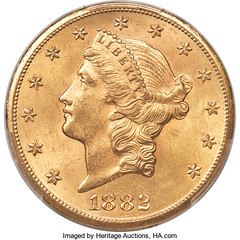
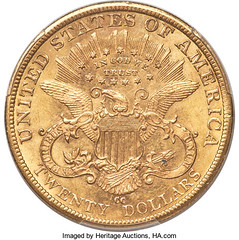
1882-CC Double Eagle
Just a few of the highlights of this auction include:
- 1807 10C JR-1, MS66 PCGS
- 1796 25C B-2, AU58+ PCGS
- 1795 $1 Flowing Hair, Three Leaves, B-5, BB-27, MS62 PCGS
- 1809/8 $5 BD-1, MS64+ PCGS. CAC
- 1795 $10 13 Leaves, BD-2, MS61 PCGS. CAC
- 1799 $10 Small Obverse Stars, BD-7, MS63 PCGS
- 1803 $10 Small Reverse Stars, BD-3, MS63 PCGS
- 1861-O $20 AU58 PCGS
- 1882-CC $20 MS63 PCGS
Bidding for Heritage's presentation of The Maurice Storck Collection occurs over three days at our headquarters in Dallas, Texas. A Signature floor session on Wednesday afternoon, October 14 begins at 2:00 PM CT, followed by online sessions on Thursday and Saturday, October 15 and 17, also starting at 2:00 P.M. CT. In total, more than 1,700 lots will carry The Maurice Storck Collection pedigree to auction. Bidding on these lots is open now at Coins.HA.com.
To read the earlier E-Sylum articles, see:
COIN DEALER MAURICE A. STORCK
(https://www.coinbooks.org/v20/esylum_v20n21a21.html)
HAPPY BIRTHDAY: MAURICE STORCK
(https://www.coinbooks.org/v21/esylum_v21n22a24.html)
MAURICE A. STORCK SR. (1922-2019)
(https://www.coinbooks.org/v22/esylum_v22n51a05.html)
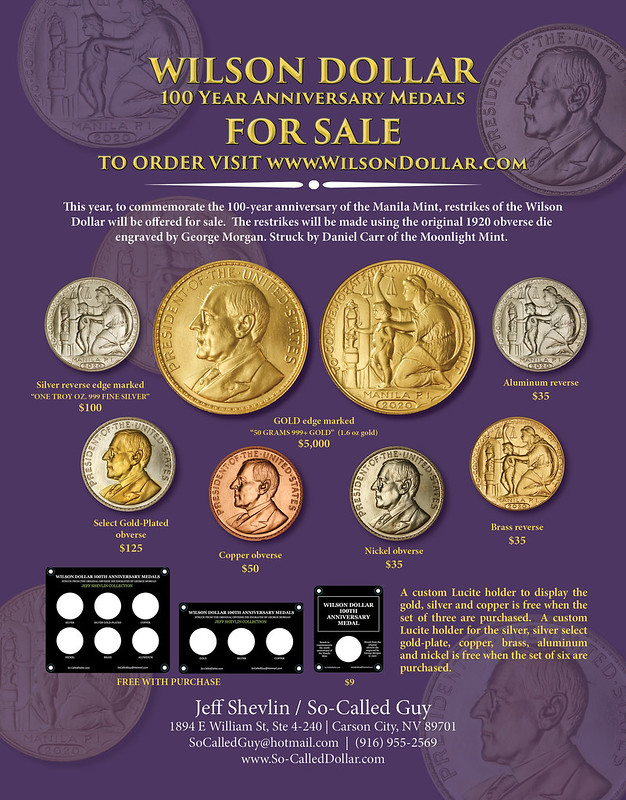
THE JOHN ROSE BRITISH TOKEN COLLECTION
Next month Dix Noonan Webb will be offering the British token collection of John Rose. Here's the announcement. Some great tokens here. -Editor
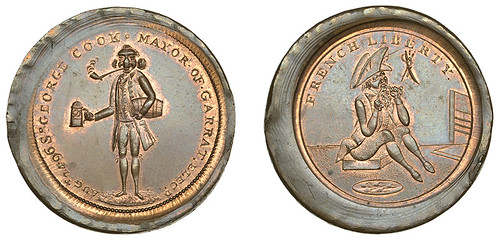
Almost 500 lots of British Tokens spanning 300 years and covering all corners of the UK from the Collection of John Rose will be offered in a live/online auction by International coins, medals, banknotes and jewellery specialists Dix Noonan Webb on Tuesday, November 17, 2020.
As Peter Preston-Morley, Specialist and Associate Director, Dix Noonan Webb, explains: "John Rose, a familiar figure in the British token collecting fraternity for many years, first developed an interest in coins as a boy. One day in 1969, going through the trays of coins at Aladdins Cave, a shop in South Croydon, he found some tokens, including an example of the 1649 farthing issued at The Ship Inn, on the north corner of Lincoln's Inn, London, his local pub when he first started work as a laboratory technician at the Royal College of Surgeons. This group is estimated to fetch £150-200."
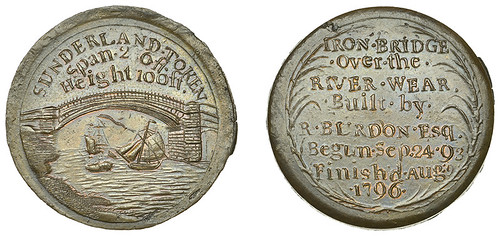
The Rose Collection is broad in its scope, but understandably London-centric and particularly so for the 17th century series, which has remained his chief focus throughout his collecting years. Many important pieces are included, and one instance is a very recent purchase, a farthing of Richard Winsper from Lincoln's Inn Gate (est: £200-300). The 18th century element of the collection also includes some major rarities, notably a highly elusive Godington hop token (est: £150-200) and several silver proofs. From the 19th century there is a superb example of John Robertson's Newcastle-upon-Tyne halfcrown (est: £400-500), and a rare ‘Chinaman' halfcrown of Edward Wright of Birmingham (est: £600-800).
The collection includes many wonderfully shaped tokens ranging from hearts to squares as well as many other shapes. As Mr Preston-Morley explains: "Heart-shaped tokens and square-shaped ones were made that way to distinguish them easily from circular ones, most people who used them in the 17th century were not literate and looked at the signs on the tokens rather than the wording – a marketing ploy, if you like!"
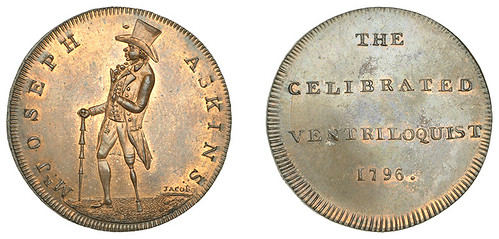
Other notable examples, which are illustrated above, include an extremely fine and rare 18th Century Lambeth token, that was made for collectors of the day, and bears the motto I promise to pay on demand the bearer one penny. It is estimated at £800-£1,000. A very fine and rare 18th Century example from Sunderland showing a view of an iron bridge with two vessels passing underneath is estimated at £500-£700. Other interesting items include from London; a very rare 17th Century Token of Newgate Within Prison, dating from 1669 (est: £300-£500) and from Clerkenwell, and 18th century token depicting a man standing with wooden leg, stating Mr Joseph Askins - the celebrated ventriloquist 1796, which is estimated at £300-£400.
For more information, see:
https://www.dnw.co.uk/
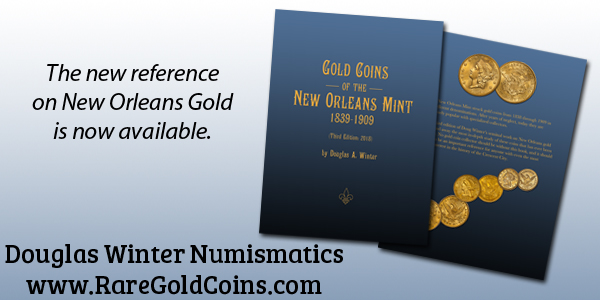
NUMISMAGRAM MEDAL SELECTIONS: OCTOBER 2020
Jeremy Bostwick at Numismagram sent along these highlights from his most recent October upload of new material. Outside of these interesting artistic endeavors, there are a number of architectural and expo-themed medals. Later this month, he will be adding some Halloween-related exonumia, so stay tuned to numismagram.com/inventory for all of these new additions. -Editor
101139 | FRANCE & GERMANY. Corbara, Corsica silver Trench Art. Engraved on an undated French Franc
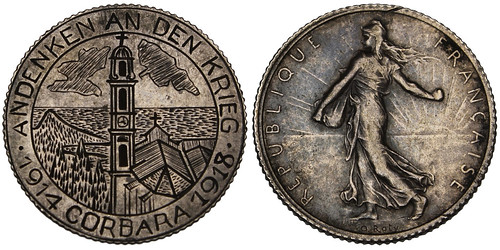
(23mm, 4.47 g, 12 h). ANDENKEN AN DEN KRIEG (souvenir of the war) / • 1914 CORBARA 1918 •, façade of the tower at the Couvent Saint-Dominique de Corbara, with a view toward the Mediterranean Sea / REPUBLIQUE FRANÇAISE, Marianne advancing left, sowing seeds; rising sun in background. Edge: Reeded. Cf. KM 844.1 (for host coin). Engraving & host coin: Choice Extremely Fine. Pleasing deep gray toning. $285.
We associate the internment of citizens during wartime as a WWII aspect with Japanese-Americans, but the practice in fact existed during WWI as well, with France using the practice toward 'enemy aliens' on the island of Corsica and utilizing the convent at Corbara represented on this interesting piece of trench art from the first world war.
Crude work, but that's the unique charm of trench art. This one is much better executed than most. Nicely done. -Editor
To read the complete item description, see:
101139 | FRANCE & GERMANY. Corbara, Corsica silver Trench Art.
(https://www.numismagram.com/product-page/101139)
101240 | GREAT BRITAIN. Holborn Restaurant bronzed pewter Medal.
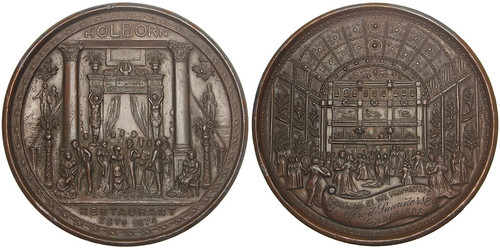
Issued circa 1894 (engraved 1898). Issued and presented to Alfred Saunders on 26 September 1898 (68mm, 209.35 g, 12h). HOLBORN / RESTAURANT ESTd 1874, interior view of the restaurant with guests standing between columns; decorative plants and sculptures around / Elaborate interior view of the restaurant with guests dancing; decorative plants and friezes around; on ribbon below, PRESENTED BY THE PROPRIETORS "To Alfred Saunders Sep 26th 1898." Edge: Plain. Taylor 207a; BHM 2990; Eimer 1640. Choice Mint State. Warm brown surfaces; thickness: 10mm. $195.
Established in 1874, the Holborn Restaurant, billed as adding a "spice of poetry to the dull prose of every day life," was located near the corner of Little Queen Street and, rather appropriately, Holborn. Gradual expansions led to more additions to the restaurant, which were fully connected in 1894. Of note, the British Chess Federation was founded there in 1904, and, in 1908, during the London Olympic games, numerous banquets for the participating athletes were held there. In 1955, the entire group of buildings was demolished.
This design is extremely busy, cramming a huge number of elements into both sides. Amazing amount of work. The architectural perspective seems off, but it's still an impressive piece. -Editor
To read the complete item description, see:
101240 | GREAT BRITAIN. Holborn Restaurant bronzed pewter Medal.
(https://www.numismagram.com/product-page/101240)
101260 | RUSSIA. St. Petersburg. St. Isaac's Metropolitan Church bronze Medal.
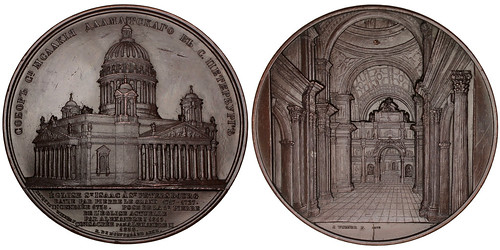
Issued 1858. Most Remarkable Edifices of Europe series (59mm, 84.59 g, 12h). By J. Wiener in Brussels and struck at the Geerts mint in Ixelles. СОБОРЪ СВ ИСААКΙЯ ДАΛМАТСКАГО ВЪ С. ПЕТЕРБУРГЪ / ÉGLISE ST ISAAC À ST PETERSBOURG BATIE PAR PIERRE LE GRAND 1717–1727. INCENDIÉE 1735. POSE DE LA 1E PIERRE DE L'ÉGLISE ACTUELLE PAR ALEXANDRE I 1819. CONSACRÉE PAR ALEXANDRE II 1858, three-quarter exterior view of the church building / Interior view looking down the nave from a vantage point just to the right of the center aisle. Edge: Plain. Ross M210 (R3); van Hoydonck 158; Reinecke 57. Mint State. Deep brown surfaces, with some pleasing brilliance remaining. While the overall luster and color are superior to others of this type, a few distractions are noted accounting for a lower designation: some scattered light marks in the upper obverse field, a light scratch in the reverse exergue near the signature, and a minor dig in the central part of the roof on the reverse. Nevertheless, highly attractive for this very rare and desirable issue. Compare to a somewhat inferior example in Stack's Bowers April 2020 CCO, lot 30015 (which sold for a total of $960). $965.
From what is today eastern Netherlands and western Germany, the Wieners were a Jewish family of exceptional medalists, especially known for numerous numismatic works throughout the Kingdom of Belgium. Eldest brother Jacques, along with younger brothers Leopold and Charles, created some of the finest works of medallic art of the 19th century, and all are particularly noted for their work in the highly detailed and intricate work of architectural renderings.
Great architectural medal - the artist does an amazing job of conveying an immense space in a small surface. -Editor
To read the complete item description, see:
101260 | RUSSIA. St. Petersburg. St. Isaac's Metropolitan Church bronze Medal.
(https://www.numismagram.com/product-page/101260)
101362 | UNITED STATES. Alaska–Yukon–Pacific Exposition bronze award Medal.
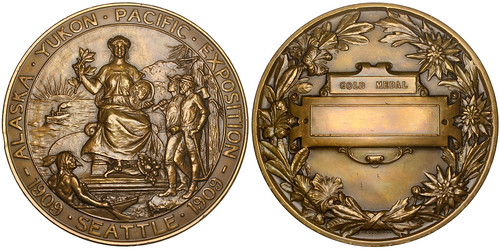
Issued 1909. Presented at the expo for the "gold" award (71mm, 178.82 g, 12h). By F. Ziegler for Gorham Manufacturing Co. – ALASKA • YUKON • PACIFIC • EXPOSITION – / 1909 • SEATTLE • 1909, Columbia seated facing, holding branch and plaque with bust of George Washington, and with foot set upon cornucopia; Native American in canoe to lower left, two prospectors to right; steamship and rising sun in background / Ornate plaque inscribed GOLD MEDAL and with the lower panel left blank for engraving; all within floral wreath. Edge: Plain. Mint State Details. Charming light brown-bronze surfaces, though some light cleaning in a few spots and a minor edge knock are noted for completeness; nevertheless, great quality for the type. $395.
Meant to cast a spotlight upon the development of the Pacific Northwest, the Alaska–Yukon–Pacific expo was originally slated for 1907 in order to commemorate the 10th anniversary of the Klondike gold rush. When the expo's organizers became aware of the Jamestown Exposition (celebrating the 400th anniversary of the city's founding), they opted to move it back two years so as not to compete. The expo was open from 1 June–16 October 1909, with over 3.7 million patrons passing through the gates. Following the show's completion, the campus of the University of Washington took the place of the former buildings and grounds.
Very detailed obverse design. There's a lot there, but it's pulled off well - it doesn't appear busy despite the large number of elements. -Editor
To read the complete item description, see:
101362 | UNITED STATES. Alaska–Yukon–Pacific Exposition bronze award Medal.
(https://www.numismagram.com/product-page/101362)
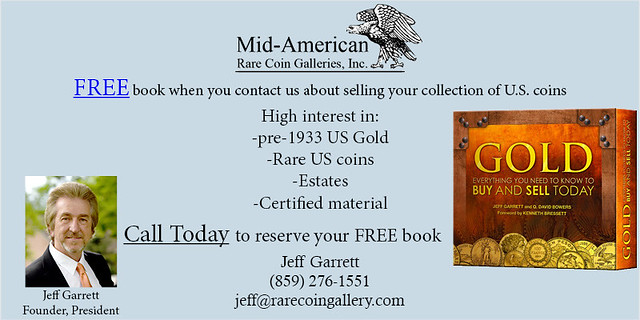
EDWARD I GROAT
Heritage Auctions is offering a nice high condition Edward I Groat in an upcoming sale. Here's the press release. -Editor
Get Your Groat: A 700 Year Old Treasure
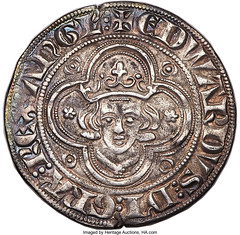
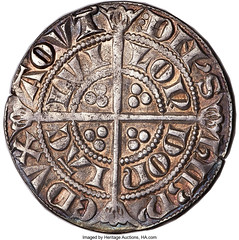
The Groat was a medieval European coin equal to 4 Pence. This long-defunct denomination is well-known to collectors of British coins. The first Groat to be struck was under King Edward I, who reigned from 1272 to 1307 AD. Edward I was the son of King Henry III, who experienced turmoil during his reign when his barons rebelled and demanded reforms. The rebellion was eventually quelled, but it was shortly thereafter when Edward learned that his father had passed away, and he was now King.
Remembered as a reformer, the newly-crowned King Edward I made changes to many laws but also focused his efforts on battles with Wales and Scotland. It was against this backdrop of military turmoil that a new denomination of coin was struck for the first time. Edward I's recoinage included the groat, the penny, the farthing, and later the halfpenny. A small denomination such as 4 Pence may not sound like much now, but this was a meaningful amount of money at the time and was struck in silver rather than a cheap base metal.
Estimated at $10,000 to $15,000, this coin really stands out for its condition. Given its age and the fact that this coin was struck approximately 700 years ago, its AU50 grade from NGC suggests a far nicer than normal example.
As Heritage Auctions catalogers explain, "A highly attractive piece, featuring a strong strike and only a few light edge cracks. Steel gray dominates the toning, but some hints of cobalt and goldenrod are evident. Most importantly, this wondrous specimen has survived intact without any of the typical problems which plague the type. This large size silver denomination was introduced under Edward I in 1279, appearing alongside the still relatively new and redesigned long-cross Penny, as well as the 1/2 Penny and Farthing, and it quickly proved to be unpopular in terms of daily circulation and monetary use. However, they were revered as decorative objects, and quite commonly covered with a layer of gilt and/or mounted for ornamentation. Untouched examples such as the present piece are an incredible rarity and deserve a great deal of attention and focus, and it is a highly interesting and important piece within British numismatics."
Check out this coin as part of Heritage's January 2021 NYINC Coin Auction #3089 here:
Edward I (1272-1307) Groat (4 Pence) ND (1279-1307) AU50 N...
(https://coins.ha.com/itm/great-britain/world-coins/edward-i-1272-1307-groat-4-pence-nd-1279-1307-au50-ngc-/p/3089-19006.s)
13TH CENTURY ISLAMIC PRESENTATION GOLD COIN
Morton & Eden are offering a rare Islamic coin in their October sale. Here's the press release. -Editor
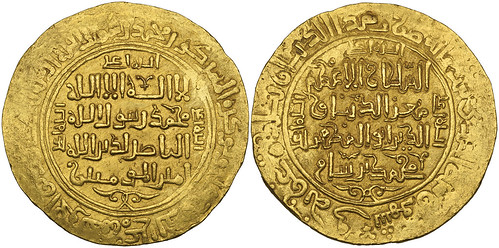
An exceptionally rare Islamic gold coin from the Ghorid dynasty, dating from the early 13th century is estimated to fetch £200,000 – £300,000 when it comes under the hammer of specialist auctioneers Morton and Eden in London in London on Thursday 22 October 2020.
Specially struck for presentation, the coin measures approximately 46mm (more than an inch and a half) and weighs a hefty 45g of pure gold.
The reason it is expected to fetch such a high price is due to the fact that it is the only known example of one of these magnificent presentation coins to bear the sole name of one of the most famous Ghorid Sultans – Mu'izz Al-Din Muhammad bin Sam (567-602h), also known as ‘Muhammad of Ghor'.
Stephen Lloyd of Morton & Eden explains: "This outstanding, large gold coin is of significant historical importance to the Islamic world and especially to India. This is because the man who issued it, Mu'izz al-Din, is credited as having laid the foundations for subsequent centuries of Muslim rule in the Indian Subcontinent."
Mu'izz al-Din Muhammad was born in Ghor, now the heart of present-day Afghanistan. Together with his elder brother, Ghiyath al-Din Muhammad, they created a vast Ghurid empire stretching from Northern India in the East to the margins of the Caspian Sea in the West.
It is Mu'izz al-Din's successful campaigns in India for which he is most well known today. As swathes of Indian territories fell under his command he quickly set about establishing Islam there, replacing existing temples with mosques and introducing Islamic precepts and legal principles. As a consequence he is widely acknowledged as having changed the course of Indian history. When Ghiyath al-Din Muhammad died in 599h (1202), Mu'izz al-Din succeeded him as sole Ghorid Sultan until he was assassinated in the Punjab in 602h (1206).
While there are similar gold coins minted at Ghazna for the years of 597h and 598h, also carefully struck to the weight of 10-mithqals/dinars, these bear the names of both Sultan brothers. This coin, however, struck a few years later in 601h (1205AD) after Ghiyath al-Din Muhammad's death, is the only one of its type to bear the sole name of Mu'izz Al Din.
Why this magnificent medallion was produced is not known for certain, although it carries the date 601h (1205), the year when the whole of Hindustan came under Mu'izz al-Din's sway. Steve Lloyd of Morton & Eden said: "This is a truly special coin. It was struck to celebrate and acknowledge the power and greatness of Mu'izz al Din (Muhammad of Ghor) at the height of his achievements in India."
This is the first time that this great rarity has been seen at public auction, having been in a European private collection for decades.
For more information, see:
https://www.mortonandeden.com/

WASHINGTON QUARTER AND PEACE DOLLAR PLASTERS
Steve Davis of Numismatic Auctions LLC passed along this additional information on the Anthony DeFrancisci and Laura Gardin Fraser plasters in his upcoming November 2020 sale #65. Thanks! -Editor
According to the consignor, these items were likely the property of Victor DeMeo, who passed in 1947 and were subsequently inherited by William DeMeo. Victor was a sculpture artist and photographer who had a longtime professional relationship with James Earle Fraser. He frequently brought his son William to the Fraser NYC studio. There they met such luminaries of the time period as Charles Gibson, Lindbergh, Ann Harding. Jack Johnston, Charles Atlas, Elihu Root, Edwin Robinson. Victor photographed James Earle Fraser and Laura Gardin Fraser in studio settings as well as his and Laura's sculptures and sculpture subjects.
William served as an apprentice with James Earle Fraser around 1932, then opened a NYC studio of his own for 12 years before serving in World War II. William worked with many well known sculptors including Anthony DeFrancisci, Paul Manship and others, making plaster pieces. These rare coinage related items being offered for auction currently were handed down through the DeMeo family, gifted from the original artists and later acquired at the estate sales of relatives of William. The most solid information surrounding these relationships came from a loose-leaf book that William produced, a notebook included in the group with hand written historical content and sketches dated 1935-36, as well as from letters and correspondence between James Earle Fraser and William DeMeo.
The lot numbers have yet to be assigned, but the descriptions for the lots are as follows:
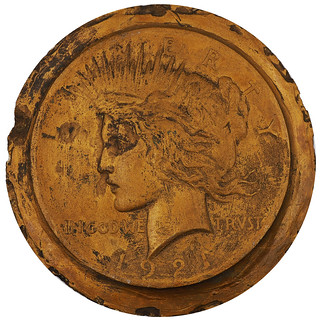
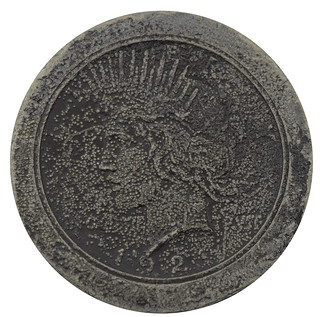
Likely Unique and Previously Unknown Original Obverse Plaster and Uniface Obverse Lead Splasher Die Trial Strike for The 1921 High Relief Peace Dollar. Features a white alabaster plaster model with yellow-ochre applied finish, 8 3/4" diameter, 1 1/4" thick, unsigned but design executed by Anthony DeFrancisci for use as the obverse of the 1921 replacement for the longstanding Morgan Silver Dollar. The design depicts a stunning art deco inspired portrait of Liberty with free flowing hair and a radiant tiara with LIBERTY at top and IN GOD WE TRUST divided at either side of the bust, date below. Overall EF, some minor chipping about the edge and mottled variation in the surface coloration due to age and some transient surface adhesions and deposits.
Accompanied by an original lead composition Uniface Splasher Die Trial striking of the aforementioned design, 45mm in diameter overall and 5mm thick, weighing in at 77.1 grams. The splasher is heavily oxidized with a thick grayish-pewter colored patina, otherwise EF to as struck, cpl light old marks likely part of the production process. The historic significance of this museum quality pair of United States Mint History relics cannot be overstated, a trophy acquisition for the Peace Dollar specialist or registry set collector, the likes of which will not present itself again. This lot contains both the Obverse Plaster and Uniface Die Trial.
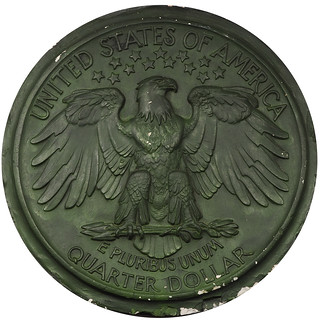
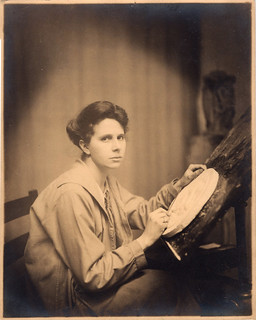
Likely Unique and Previously Unknown Original Unadopted Reverse Plaster and Original Studio Photograph of Laura Gardin Fraser Sculpting the Washington Quarter Design, c. 1931. Features a white alabaster plaster model with olive green applied finish, 11 1/2" diameter, 1 1/4" thick, with integral wire hangar as made on back, unsigned but design executed by Laura Gardin Fraser for use as the reverse of the 1932 George Washington Commemorative replacement for the Standing Liberty Quarter. The design depicts a magnificent Eagle in Heraldry with arrows and olive spray in talons, 13 stars above with UNITED STATES OF AMERICA at top while the Motto E PLURIBUS UNUM and QUARTER DOLLAR denomination reside below. Overall EF or better, some random minor chipping about the edge and to the finish, cpl trivial cracks in the surface coloration due to age and some scattered areas of regional age toning and insignificant sediment/dust in devices.
Accompanied by an original sepia tone 8"x10" Studio photographic portrait print of Laura Gardin Fraser at her easel, sculpting what appears to be the obverse for the aforementioned plaster. The image was lightly pierced at the top with a single pinhole for suspension, but otherwise perfect and accented by some peripheral silvering. The image conveys a rare window in time, viewing one of America's most noteworthy coin designers at work. Although this Quarter Dollar design was selected by the Council for Fine Arts as the rendering for coinage, then Treasury Secretary Andrew Mellon overruled the Committee and selected John Flanagan's design in its place.
With a fast forward leap to commemorate the 200th Anniversary of George Washington's death, Laura's design finally came to numismatic fruition on the $5 Gold Commemorative coinage of 1999. Once again as with the preceding lot, this discovery and offering of these amazing pieces, their historic nature and importance are utterly indescribable. An important opportunity for the advanced collector of U.S. Mint History, the Washington Quarter specialist or registry set collector, as well as mavens of Fraser's coinage and medallic art. This lot contains both the Reverse Quarter Dollar Plaster and Studio Portrait.
Steve adds:
"I am so excited to offer these to the Numismatic community for the first time!"
It's not every day that opportunities like this appear. Great chance to acquire important artifacts in numismatic history. -Editor
For more information on the sale, see:
https://numismaticauctionsllc.com/
To read the earlier E-Sylum article, see:
NUMISMATIC AUCTIONS LLC SALE 65
(https://www.coinbooks.org/v23/esylum_v23n37a26.html)
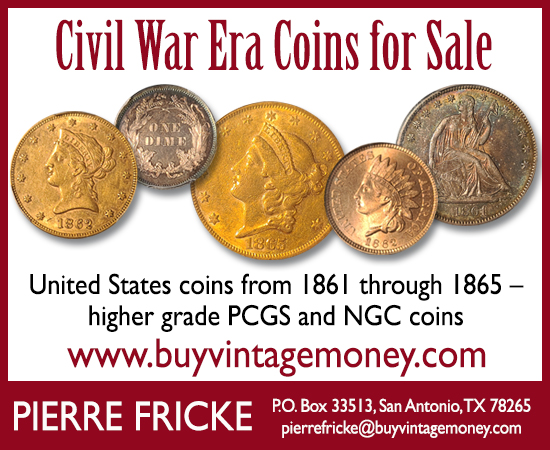
HALF CENTS STRUCK ON TALBOT, ALLUM & LEE TOKENS
On September 9, 2020 Dave Bowers published this Mint News Blog article on a hoard of Talbot, Allum & Lee coppers and their repurposing as planchets for U.S. half cents. -Editor
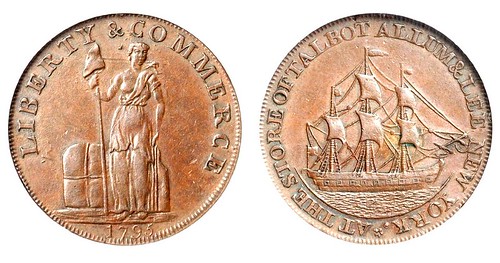
At 241 Water Street in lower New York City, the firm of Talbot, Allum & Lee engaged in the India trade, importing goods by ship. Formed in 1794, the partnership operated only until 1796. Principals included William Talbot, William Allum, and James Lee. This particular district of the city was a beehive of activity with vessels continually arriving and departing. Numerous ships' chandlers, grog houses, cheap lodging places, and other establishments for the convenience of sailors did a lively business.
Copper tokens dated 1794 and 1795 bearing the image of the standing goddess of Commerce on the obverse and a fully-rigged sailing ship on the reverse were struck to the order of Talbot, Allum & Lee by Peter Kempson & Co., Birmingham, England, and imported into America by the partners. The quantity has been estimated at over 200,000 coins, but no original records have been located.
At the time, copper coins in circulation in New York and nearby areas were a curious assortment of issues made by or for various states (Connecticut, Massachusetts, New Jersey, New York, and Vermont), British halfpence, counterfeits, and other pieces. The Liberty Head copper cents made at the Philadelphia Mint beginning in March 1793 were not particularly numerous. Generally, just about any copper coin the size of a British halfpenny (about the same size as an American cent) would trade in commerce at the value of one cent. It was popular speculation and, at the same time, a worthwhile advertising scheme to have copper tokens privately struck for a cost of less than a cent apiece, and pay them out at one cent.
In accordance with this practice, Talbot, Allum & Lee tokens dated 1794 were put into circulation where they served at the value of one cent in local and regional commerce. Pieces dated 1795 seem to have been less popular. Apparently, undistributed tokens piled up at the waterfront store. What should be done with the hoard?
The answer came quickly. On April 23, 1795, the firm sold 1,076 pounds of the tokens to the Philadelphia Mint for 18¢ per pound, or $193.68. On December 10, 1796, the remainder of the token stock amounting to 1,914 pounds of copper was purchased by the Mint from William Talbot for $319, or 16.6¢ per pound. These tokens weighed in at about 46 to 50 to the pound, equivalent to around 140,000 to 150,000 pieces acquired in the Mint's two purchases.
The coins were a godsend to the Mint, which had been experiencing severe difficulties obtaining copper stock from which to strike half cents and cents. Supplies of this metal were erratic and of uncertain quality and included such varied sources as copper sheet for roofing and the protection of ships' hulls, and old pots and kettles.
Planchets for United States half cents were cut by punching discs from the Talbot, Allum & Lee tokens, most of which were probably in mint condition. Today it is not unusual to find a 1795 or 1797 U.S. half cent (but not one dated 1796) with faint traces remaining of the token undertype — usually some of the ship's rigging and/or some of the letters around the border of the token. Such half cents are highly prized by numismatists as they are literally two coins in one.
I reached out to Half Cent expert Bill Eckberg who kindly pointed me to images from the Davy collection at Goldbergs showing various traces of the undertype. Thanks! Here's Lot 41, a 1795 Half Cent double struck over a 1794 Talbot Allum & Lee Cent. On the obverse below the date are signs of the letters "OMM" in "COMMERCE" and more lettering on on the reverse -Editor
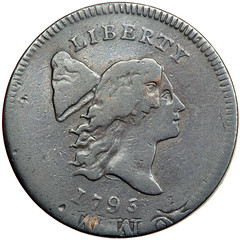
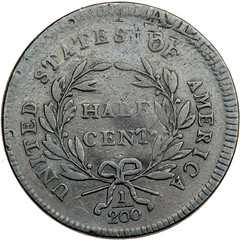
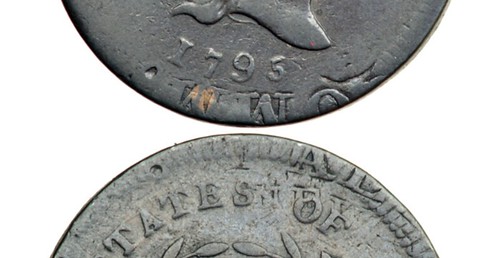
Regarding Lot 70, Bill writes:
"This one is best of the three. Plenty of lettering visible. Usually, all you see is bits of ship rigging. Lot 34 has undertype from the ship's rigging below the left side of the date. Lot 41 has lots of undertype from ship rigging and lettering on the reverse."
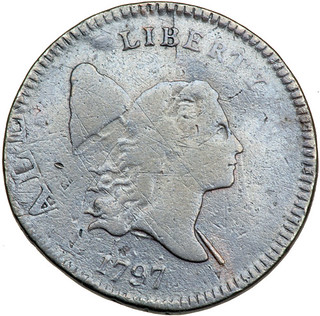
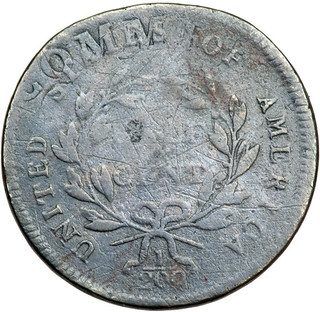
Lot 70, a 1797 Half Cent struck on a 1794 Talbot Allum & Lee Cent
To read the complete lot descriptions, see:
Lot 34
1795 C-6a R2 Plain Edge without Pole on Thin Planchet F12
(http://images.goldbergauctions.com/php/lot_auc.php?site=1&sale=60&lot=34)
Lot 41
1795 C-6a R2 Plain Edge without Pole on Thin Planchet VF20.
(http://images.goldbergauctions.com/php/lot_auc.php?site=1&sale=60&lot=41)
Lot 70
1797 C-1 R2 1 Above 1 Variety VG8.
(http://images.goldbergauctions.com/php/lot_auc.php?site=1&sale=60&lot=70)
To read the complete article, see:
Bowers on collecting: Focus on a famous hoard — Talbot, Allum & Lee coppers
(https://mintnewsblog.com/bowers-on-collecting-focus-on-a-famous-hoard-talbot-allum-lee-coppers/)
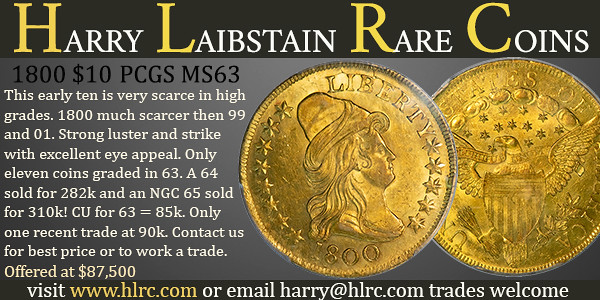
TENDER: AN EDGE-LETTERED CENT ART PROJECT
Gerry Tebben passed along this New York Times article about an art project distributing edge-lettered cents. Thanks! -Editor
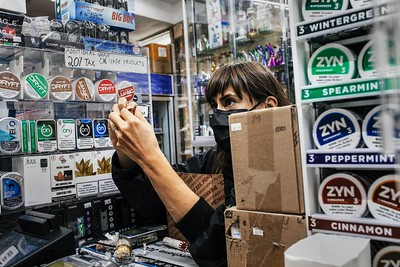
The artist Jill Magid describing her art project, "Tender,"
at a shop in Manhattan's financial district.
A conceptual artist walked into a bodega during a pandemic carrying a box full of pennies.
The place was one of those ubiquitous New York smoke shops that uses tobacco pipes in their signage instead of the letter "S." The artist was named Jill Magid, and she approached the man at the counter, giving a pitch that she didn't quite have down to elevator length.
"I want to pay for this in pennies," she said, picking up some Ferrero Rocher chocolates. "They're engraved as part of a dispersed monument. See?"
The clerk put on his glasses and squinted at the edge of a coin. "The. Body. Was. Already. So …"
"Fragile!" Ms. Magid finished for him. "You have good eyes."
"It's too small," the clerk concluded.
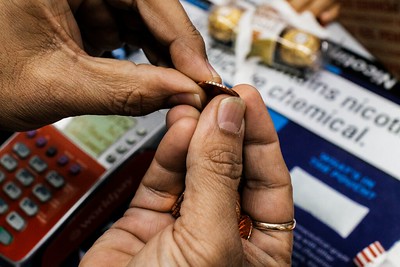
In the end, he seemed to understand. He accepted the pennies, and Ms. Magid strolled out with her chocolates. She had several hundred more bodegas to go.
Last week, Ms. Magid was walking around the Financial District and dispersing hundreds of pennies, the first portion of a complex public artwork she calls "Tender." She had already spent four months securing the coins from various banks and finding a man in Sheepshead Bay who could build a machine to engrave their sides with the same tiny text.
The plan? Ultimately to inject 120,000 pennies into the economy of the five boroughs throughout the year, with that number being symbolic of the $1,200 checks that many Americans received at the beginning of the coronavirus outbreak. For most of the project, she would be followed by a Brink's armored truck — meant to evoke the mobile morgues that had become one of the most enduring images of a pandemic-stricken city. But for now she was on foot.
"This part of the project is, excuse the pun, the most pedestrian," Ms. Magid said, walking to the next drop-off point.
The artist was referring not only to the literal act of walking around New York City but also the fact that the dispersal of coins was the least cerebral part of the endeavor. "Tender," which was funded by the nonprofit arts group Creative Time, is supposed to bring art to regular people. But given that the totality of its meaning depends on many details, down to the font used for the coins, it was no wonder that those regular people sometimes got confused.
Fun project. I hope some of these pieces end up in collections and catalogs. Someone should take a clear photo of the edge lettering. And what does the lettering device look like? A modern-day Castaing machine? She reminds me of my friend J.S.G. Boggs, another conceptual artist who loved making people think twice. -Editor
As a conceptual artist, Ms. Magid focuses on creating moments of exchange with people she might not otherwise spend time with. In 2007, she offered to teach a New York police officer about art in return for shadowing him. (He declined the lessons, but let her follow him around and gave her a hollow-point bullet.)
Her art also has a stunt quality. In 2015, she exhumed the remains of Luis Barragán, the great Mexican architect, and ultimately enlisted a laboratory to pressurize the carbon of the bones into a diamond. "The Proposal," the film she made about trying to trade the jewel made from Barragán's bones for access to his archive, was well received. Many Mexicans, though, were less than thrilled, with some critics likening the work to necrophilia and others demanding an investigation into how that was even allowed to happen.
"Tender" was a different kind of project. "Usually in my work, I'm the protagonist," she said, "but with this one I want to disappear." For the penny distribution, she was dressed like an extra — from her zip-up Chelsea boots to her mask, she was in all black — though she was on the way to meet a film crew meant to record a transaction across from One World Trade.
When Ms. Magid got to the meeting spot on Vesey Street, at least a half-dozen people were waiting for her. The area was relatively free of traffic, and it seemed like securing the shot of her walking into a bodega and dropping off the coin rolls would be a cinch. But by the time they set up the equipment and the Brink's truck had arrived, at around 11:30 a.m., cars had started spilling out of an adjacent parking garage, complicating the shot. It took more than 40 minutes to capture it.
To read the complete article, see:
Why This Artist Is Paying Bodegas With 120,000 Pennies
(https://www.nytimes.com/2020/10/01/nyregion/nyc-bodega-pennies-jill-magid.html)
Here's some more from the project website. -Editor
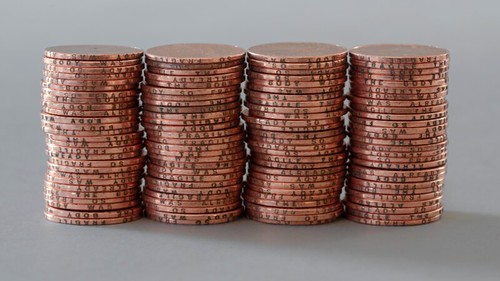
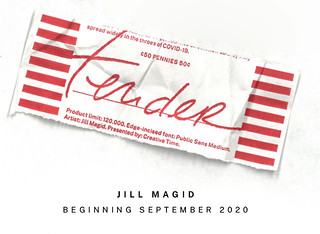 In Creative Time's most widespread public art commission to date, Jill Magid intercedes in our national economy, responding to issues of value in the throes of COVID-19 with her first major U.S. public art project, entitled Tender. Magid disseminates 120,000 2020-issued pennies, the edges of which she engraved with the appropriated phrase, "THE BODY WAS ALREADY SO FRAGILE." The text evokes both the human body and the body politic—and underscores their interconnection during the coronavirus pandemic.
In Creative Time's most widespread public art commission to date, Jill Magid intercedes in our national economy, responding to issues of value in the throes of COVID-19 with her first major U.S. public art project, entitled Tender. Magid disseminates 120,000 2020-issued pennies, the edges of which she engraved with the appropriated phrase, "THE BODY WAS ALREADY SO FRAGILE." The text evokes both the human body and the body politic—and underscores their interconnection during the coronavirus pandemic.
Magid utilizes pennies—whose newly minted copper surfaces are antimicrobial—as a dispersed monument that will spread discretely across the country, beginning in New York, to explore the contradictions between the dissemination of currency and COVID-19. With an average circulation of 40 years, this project will exist as long as the pennies are in use, and as rumor. In this way, Magid reimagines public art as not a static entity, but rather as a phenomenon that circulates freely among the population; each transaction builds social relations in networks of exchange and interconnectivity.
For more information, see:
https://creativetime.org/tender-jill-magid/
THE BOOK BAZARRE
THE HORSE GAMING TOKENS OF SZECHUAN
Stack's Bowers Senior Numismatist and Cataloger Jeremy Bostwick published a blog article this week on the horse gaming tokens of Szechuan. I'd never seen these before. -Editor
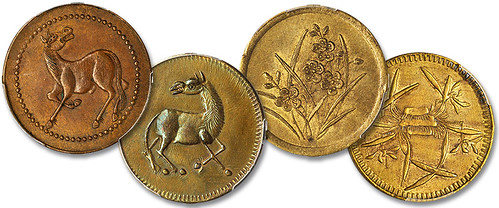
Much like the American pastime poker often involving some friendly monetary wagering, so too it is for Mahjong in a large portion of the Far East. Though playing cards have been around for over a millennium, likely being introduced in the 9th century A.D. (coincidentally enough, during China's Tang dynasty), the game of Mahjong likely had its debut during China's final imperial family, the Qing dynasty in the mid-18th century. Involving 144 tiles with various symbols and Chinese characters, it is generally played with four players employing a turn-based strategy and may have derived from an earlier game known as Mah-tiae ("hanging horse"). Numerous variants to general game play and house rules can exist, though the overall look to the design on the tiles tends to remain fairly consistent, with bamboo and flowers, for example, playing a large role. Given the scoring system involved, the use of gaming counters or tokens is a necessity, with many tile sets often including them as well. Any type of counter, however, can obviously fill this 'token' role, allowing for a player to personalize their set and, in turn, the gaming experience.
In our upcoming October 2020 Hong Kong auction—our largest such auction to date—a vast array of rather unusual gaming tokens will be offered. These interesting pieces of exonumia are not widely understood, though they have been attributed to the province of Szechuan and dated to the second decade of the 20th century. Mostly employ the image of a horse in a variety of poses. The reverses offer a bit more variance, as they generally feature reeds and flowers very similar to those found on some of the Mahjong gaming tiles. In addition to the variety of horse poses and reverse iconography, metallic content and modules can vary, allowing for the collector to pursue any number of collecting avenues. It remains uncertain what their intended role was, but the ubiquitous nature of Mahjong as well as the need for reckoning its scoring make these "horse gaming tokens" a likely candidate in the early years of the Chinese Republic. Whether one is an advanced collector in search of a highly specific variety or a beginner simply looking to add something from the peripheries of numismatics, this incredible group—likely the largest and most diverse offered—will satisfy all who are able to score a token or three.
To read the complete article, see:
The "Horse Gaming Tokens" of Szechuan
(https://www.stacksbowers.com/News/Pages/Blogs.aspx?ArticleID=horse-gaming-tokens-szechuan)
Here's one example. The bidding was up to $8,500 last I checked earlier today. -Editor
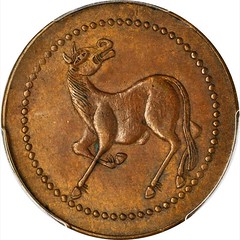
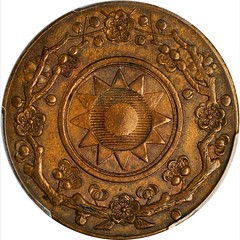
CHINA. Szechuan. Copper Horse Gaming Token, ND (ca. 1912). PCGS AU-55 Gold Shield.
CL-SCM.12a var. (white metal). Though listed on the holder as SCM-12, this example is clearly the more difficult of the two types--SCM-12a--featuring a larger central circle on the reverse as well as fewer berries in the wreath. CL only lists 12a in white metal, making this red copper specimen easily on par with the EXTREMELY RARE level-3, or quite possibly even more so.
Estimate: $1,500 - $2,500.
To read the complete lot description, see:
CHINA. Szechuan. Copper Horse Gaming Token, ND (ca. 1912). PCGS AU-55 Gold Shield.
(https://auctions.stacksbowers.com/lots/view/3-O5JOP/china-szechuan-copper-horse-gaming-token-nd-ca-1912-pcgs-au-55-gold-shield)
To see all of the lots, see:
CHINA. Szechuan. Brass Gaming Token, ND (ca. 1912)
(https://auctions.stacksbowers.com/lots?sort=auction_date_lot_number_asc&search=szechuan
+gaming&limit=48&lots_range=upcoming)

CRIMEAN WAR MEDALS OFFERED
Dix Noonan Webb will be offering an early Victoria Cross and other Crimean War medals in their upcoming sales. -Editor
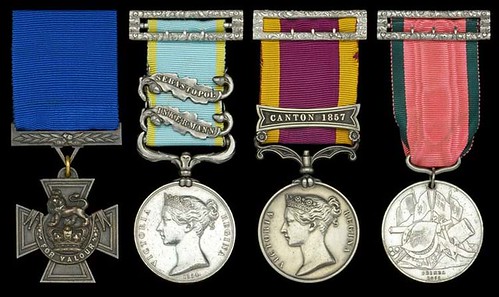
One of the earliest Victoria Crosses ever awarded is coming to auction at London specialist saleroom Dix Noonan Webb.
It was given to Australian resident Seaman James Gorman of HMS Albion, for his gallantry while defending the right Lancaster Battery at the Battle of Inkerman in the Crimean War on November 5, 1854.
The estimate at the October 15 auction will be £120,000-160,000.
This was one of three VCs awarded for this battery action – the other two are both held in the Lord Ashcroft Collection at the Imperial War Museum in London. Lord Ashcroft is a regular buyer of VCs via auction and private deals.
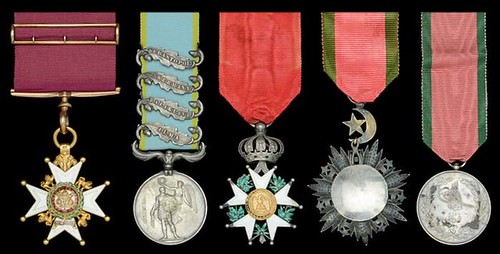
Also featuring in the DNW sale will be a collection of medals from the Charge of The Light Brigade. The most important being a group of five awarded to Major-General John Douglas, who commanded the 11th Hussars during the Crimean War, and led them in the charge at Balaklava, which is estimated at £15,000-20,000.
Douglas, who was born at Gartcraig, Lanarkshire, Scotland on April 25, 1811, joined the 61st Foot as an Ensign in 1829, immediately transferring to the 79th Foot. Advancing to captain in 1839 he was invited, six months later, into the 11th Hussars.
The following September, Douglas achieved a certain notoriety when acting as second to his commanding officer, John Thomas Brudenell, the 7th Earl of Cardigan, in his notorious duel with Captain Tuckett on Wimbledon Common. Cardigan later commanded the Light Brigade and led the Charge of the Light Brigade.
To read the complete article, see:
Very early Victoria Cross awarded for Crimean War gallantry features in London auction
(https://www.antiquestradegazette.com/news/2020/very-early-victoria-cross-awarded-for-crimean-war-gallantry-features-in-london-auction/)
STEVENS MEDAL FOR STUDENTS IN ART
Daniel Fearon submitted this press release on his recent sale of an interesting medal to the British Museum. Nice piece. Thanks. -Editor
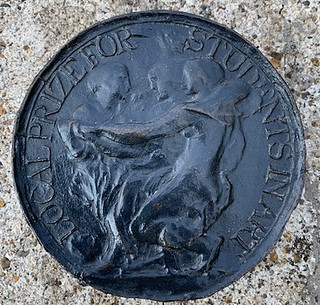 Daniel Fearon, the numismatic consultant, has just brokered the sale of an important
and long-lost cast bronze medal by the painter, designer and sculptor Alfred Stevens
(1817-1875), to the British Museum. In 1856 Stevens entered a competition for the
design of "The Local Art Prize Medal of the Department of Science and Art". It was a
competition finally won by Antoine Vechte with his high Victorian design filled with
minute detail and made by the then new electrotype process. Stevens's design was
quite the opposite and a wonderfully free design with three flowing figures. It is some
6 inches in diameter and uniface, as dictated by the terms of the competition and has a
fine dark patina.
Daniel Fearon, the numismatic consultant, has just brokered the sale of an important
and long-lost cast bronze medal by the painter, designer and sculptor Alfred Stevens
(1817-1875), to the British Museum. In 1856 Stevens entered a competition for the
design of "The Local Art Prize Medal of the Department of Science and Art". It was a
competition finally won by Antoine Vechte with his high Victorian design filled with
minute detail and made by the then new electrotype process. Stevens's design was
quite the opposite and a wonderfully free design with three flowing figures. It is some
6 inches in diameter and uniface, as dictated by the terms of the competition and has a
fine dark patina.
Philip Attwood, the retiring Keeper of the Department of Coins and Medals at the British Museum, had published back in 1992, "The Medals of Alfred Stevens" in a FIDEM publication "Designs on Posterity", where he noted Stevens's sketches and a somewhat distressed plaster model languishing in the Victoria and Albert Museum. At that time he did not know of the bronze medal, so it seems fitting that this should be his last acquisition as Keeper.
The bronze was originally in the collection of Sir Charles Holroyd (1861-1917) who was responsible for founding the collection of works by Alfred Stevens at the Tate Gallery [Tate Britain] and, indeed, it was probably lent to the memorial exhibition at the Gallery, "Works by Alfred Stevens", 15 November 1911 – 15 January 1912. It then vanished from sight to be discovered by the architect and exhibition and museum designer, Alan Irvine. It is from his collection that it finds its way to the British Museum.
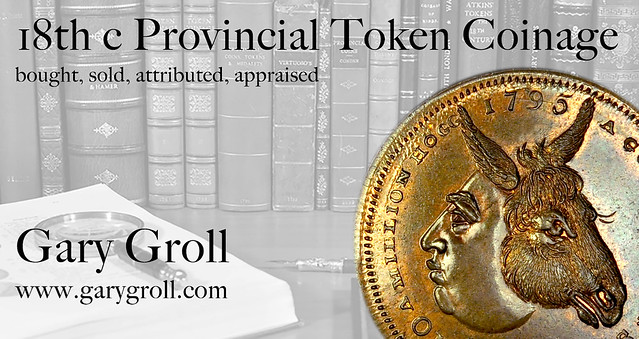
OFF-CENTER SILVER WASHINGTON QUARTER BROCKAGE
Here's the press release for another interesting coin in an upcoming Heritage sale. Great error! -Editor
Error Coin Sidelines George Washington
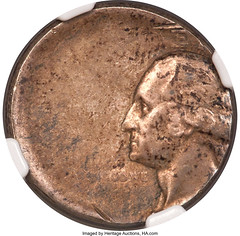

George Washington has been relegated to the sidelines on a fabulous error coin that Heritage will be offering in the December 15th special error coin auction. In a world of collecting where mistakes are desirable and often very valuable, error coins are highly sought after by collectors as examples of what can go wrong when the careful, precise US Mint makes a mistake!
Graded AU58 by NGC and showing the very slightest touch of rub, this crazy-looking coin must have been set aside nearly immediately after it was struck. It is a dual error, combining both an off-center strike and a brockage. The obverse (the "heads" side) is struck 40% off-center, and there is a brockage on the reverse.
A brockage is an uncommon mint error that can occur when an already-minted coin sticks to the die and impresses onto another blank that has not yet been struck. This results in a fascinating error where one side of the coin has the normal design and the other side has a mirror image of the same design impressed upon it. The coin will have either two fronts (obverses) or two backs (reverses), with one being a mirror image of the other.
In the case of this coin, two heads are better than one--poor sidelines Mr. Washington appears way off to the right of the obverse, with a backwards image of his head on the left side of the reverse. No tails side for this coin!
Collectors can conjecture about the year, which is not visible on this particular coin. However, it was struck on the 90% silver planchets that were used for the Washington Quarter's vintage years of 1932 to 1964, which makes sense given the rich tone that the coin has developed over the years--the coin was not minted recently and has naturally toned over time.
See this great coin for yourself, as part of the Error Coin Auction #60179 here:
No Date 25C Silver Washington Quarter -- Struck 40% Off Ce...
(https://coins.ha.com/itm/errors/no-date-25c-silver-washington-quarter-struck-40-off-center-with-reverse-brockage-au58-ngc/p/60179-11001.s)

AFRICAN-AMERICANS AND THE FREE SILVER CAMPAIGN
In the American Numismatic Society's blog Pocket Change, Jesse Kraft discusses the 1896 Free Silver campaign and its influence on African-American voters. Here's an excerpt - see the complete article online. -Editor
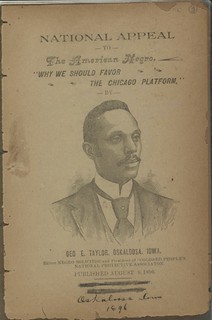 In the latest issue of the ANS Magazine, Helena Kagan wrote an admirable article that articulated the nuances of the Free Silver campaign led by Democratic nominee, William Jennings Bryan, during the Presidential race of 1896. Republicans, with William McKinley as their candidate, were in favor of keeping the gold standard as the sole basis for our nation's currency. This group of monometallists was dubbed the "St. Louis platform." Democrats on the other hand were for the free coinage of silver, allowing silver and gold to circulate together at a rate of 16:1—polymetallists known as the "Chicago platform."
In the latest issue of the ANS Magazine, Helena Kagan wrote an admirable article that articulated the nuances of the Free Silver campaign led by Democratic nominee, William Jennings Bryan, during the Presidential race of 1896. Republicans, with William McKinley as their candidate, were in favor of keeping the gold standard as the sole basis for our nation's currency. This group of monometallists was dubbed the "St. Louis platform." Democrats on the other hand were for the free coinage of silver, allowing silver and gold to circulate together at a rate of 16:1—polymetallists known as the "Chicago platform."
Notably, as Kagan concludes, Bryan and the Free Silver campaign was not a mere blip in United States politics that was gone by the next election cycle, but one that had initiated a shift of progressive ideals towards the Democratic Party that culminated with President Franklin D. Roosevelt—who often receives credit for this turn. In fact, Kagan notes that much of the New Deal had incorporated much of the Democratic platform of 1896 and the basic motives for Bryan are now fully implemented into the national monetary system. While the United States uses neither gold nor silver coinage, the fiat currency now in circulation largely encapsulates the spirit of the Free Silver campaign.
In the 1890s, there was, perhaps, no other group of people where this shift was more apparent than with African-American voters. Despite being largely disenfranchised and driven from the political process in much of the United States, various African-American leaders voiced their opinion on the topic of the currency standards of the United States. A number of these leaders backed the Democrats on the free coinage of silver, even going as far as throwing their entire support behind the Democratic Party and against the Party of Lincoln, supporting the same Democrats who were the most active in keeping African-Americans voters from participating in the political processes. In May of 1895, for instance, the Daily Public Ledger commented that "the Democratic Party is always for something free. It has advocated free whisky and Free-trade, and of course it must next declare for free silver. The only thing which the Democrats did not want free was the Negro."
In his Advice to the Colored Voters of the United States (1896), John Duker, African-American author and proprietor argued two main reasons of why the usage of silver alongside gold would be beneficial to the economy, and why this would not reduce the national currency to "commercial demoralization," as many monometallists had predicted.
To read the complete article, see:
THE FREE SILVER CAMPAIGN OF 1896 AND ITS INFLUENCE ON AFRICAN-AMERICAN VOTERS
(http://numismatics.org/pocketchange/1896-2/)
MAGGIE LENA WALKER'S SAVINGS BANK
A September 25, 2020 Wall Street Journal article profiles Maggie Lena Walker, the first Black woman to run a U.S. bank. -Editor
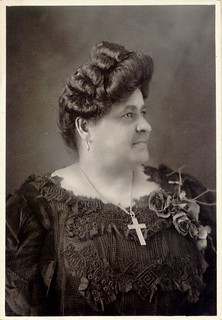 Citigroup Inc. recently announced that Jane Fraser would become its chief executive next year, making her the first woman CEO of a major Wall Street bank. If Ms. Fraser has finally cracked the glass ceiling, it was Maggie Lena Walker who first battered down the walls.
Citigroup Inc. recently announced that Jane Fraser would become its chief executive next year, making her the first woman CEO of a major Wall Street bank. If Ms. Fraser has finally cracked the glass ceiling, it was Maggie Lena Walker who first battered down the walls.
The daughter of a former slave, Walker became the first Black woman ever to head a U.S. bank when she founded the St. Luke Penny Savings Bank in Richmond, Va., in 1903. Her success came from doing what great entrepreneurs do: Walker zeroed in on an underserved market and focused her prodigious energy on meeting its needs.
Walker had worked as an insurance agent and had taken correspondence courses in business and accounting, where the color of her skin wouldn't disqualify her from participating. The manager of one white bank in Richmond allowed Walker to spend several hours a week there for months, studying how banking worked down to the finest details.
At the time, many white banks refused to lend to Black borrowers. Those that did often charged higher rates, creating resentment and further hardship that drove borrowers to pawnbrokers, payday lenders and loan sharks.
In 1865, Congress created the Freedman's Savings & Trust Co. to serve formerly enslaved people. In 1874, the bank's corrupt and incompetent white managers ran it into the ground. Most depositors reclaimed no more than 60% of their money; many lost everything.
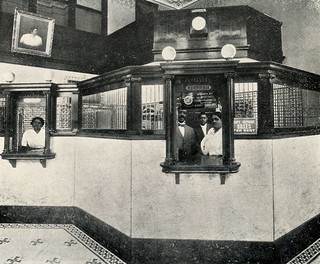 Walker made loans as small as $5. The bank kept evening hours six days a week to accommodate workers who labored past 5 p.m.
Walker made loans as small as $5. The bank kept evening hours six days a week to accommodate workers who labored past 5 p.m.
Walker knew impoverished borrowers could be honest and diligent. So she turned local communities into ad hoc credit committees, enabling St. Luke to lend to borrowers with trustworthy references.
By the 1920s, at least 100 Black women worked at St. Luke's enterprises, probably more than at any other organization in the U.S. financial industry, according to Prof. Garrett-Scott.
In 1930, St. Luke absorbed two smaller Black banks in Richmond to become Consolidated Bank and Trust Co., which Walker shrewdly steered through the hardest years of the Great Depression. In 2009, its holding company was acquired by what is now Huntington, W.Va.–based Premier Financial Bancorp. Inc.
To read the complete article (subscription required), see:
The Daughter of a Slave Who Did the Unthinkable: Build a Bank
(https://www.wsj.com/articles/the-daughter-of-a-slave-who-did-the-unthinkable-build-a-bank-11601051297)
To read an earlier E-Sylum article, see:
THE HISTORY OF THE FREEDMAN'S BANK
(https://www.coinbooks.org/v23/esylum_v23n34a15.html)

RITUALLY-KILLED COINS?
Bob Van Arsdell writes:
"I enjoyed the Money People Hated article last week.
"In Celtic societies, these kind of coins are often called "ritually killed".
"Last year I published an article about this, exploring whether there was any sort of ritual involved. The idea that people were damaging coins to send messages was also discussed. It describes various kinds of damage and the likely causes."
Thanks. Here's a short excerpt - see the complete article online. -Editor
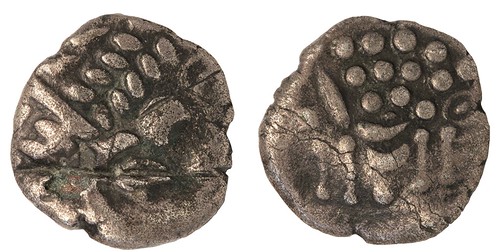
Semiotics of Celtic Coins XV – People Breaking Things
By Robert D. Van Arsdell
Ritually-killed coins?
The damaged coin at the top of this article appeared in May 1987. It was described as one of many such coins found in a hoard of Durotrigan silver staters. There was no other information available and although Badbury-Shapwick is an attractive suggestion, the likely hoard was never identified. At the time, I merely assumed this was an example of a "ritually-killed" coin and thought little more of it.

Philip de Jersey's 2005 paper on defaced coins recorded two other Durotrigan hoards with damaged coins: Upton (Nursling) 1995 and a second hoard also thought to have been found at Nursling in 1997. In 2014, he sensibly suggested that the 1995 parcel was a scatter of coins disturbed by plowing and the 1997 parcel was the undisturbed portion buried below plow-level.
It now appears that another hoard with defaced coins may have been found eight years before the Upton hoards. The passage of time makes it unlikely we will ever be able to identify more of the coins, or establish that a hoard was indeed found.
The term "ritually-killed" is laden with emotional connotations such as "savage religious rites" and "violence". It should be dropped if we are to appraise the coins in a sensible manner. The fact that the term is so attractive is worth scrutiny. Where did it come from? More to the point, what does it tell us about human behavior? Were people trying to "send a message" – is something semiotic going on?
To read the complete article, see:
Semiotics of Celtic Coins XV – People Breaking Things
(https://vanarsdellcelticcoinageofbritain.com/articles-numismatic_ccb3/van_arsdell_2019b_ccb3.html)
To read the earlier E-Sylum article, see:
MONEY PEOPLE HATED: DAMNATIO MEMORIAE
(https://www.coinbooks.org/v23/esylum_v23n39a29.html)
LOOSE CHANGE: OCTOBER 4, 2020
Here are some additional items in the media this week that may be of interest. -Editor
More on Damnatio Memoriae on Roman Coins
Last week we featured a CoinWeek article by Mike Markowitz about damnatio memoriae on ancient Roman coins. Curator Elana Stolyarik of the American Numismatic Society wrote about these in a September 29, 2020 blog article. Here's an excerpt. See the complete piece online - there are many great coin images. -Editor
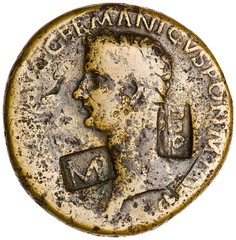
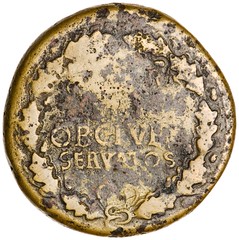
During his short reign (37–41 CE), Caligula declared himself a god and tried to exclude the Senate from the political process to establish an absolute monarchy in Rome. This situation finally led to his murder on January 24, 41 CE. He was so hated that he received the dubious distinction of being the first Roman ruler whose memory was condemned. This damnatio memoriae, "condemnation of memory,"included the destruction of his statues and public inscriptions. His coins did not escape this condemnation; they were pulled from circulation and melted down whenever possible. Some of them were countermarked, like several bronze coins from the ANS collection. These bear the countermark TICA celebrating the new emperor Tiberius Claudius Augustus and also effacing the features of Caligula's portrait.
Another Roman ruler, mostly remembered for his extravagance and tyrannical behavior, was the emperor Nero (54–68 CE). After his suicide on 9 June 68 CE, the Senate formally declared him an official enemy of the Roman state and his memory was condemned. His commemorative monuments, such as the triumphal arch in Rome honoring victories in Armenia seen on an ANS sestertius, were destroyed.
Neronian bronze coins, like the Caligula coins before, were countermarked. The stamp SPQR (Senatus Populusque Romanus) not only canceled and revalidated Nero's coins, but also symbolically reclaimed them for the Senate and Roman People.
To read the complete article, see:
DESTRUCTION OF EMPERORS' IMAGES ON ROMAN COINS FROM THE ANS COLLECTION
(http://numismatics.org/pocketchange/imperial-images/)
To read the earlier E-Sylum article, see:
MONEY PEOPLE HATED: DAMNATIO MEMORIAE
(https://www.coinbooks.org/v23/esylum_v23n39a29.html)
Coin Pricing Surge
In his Publisher's Message this week, coin pricing publication Greysheet publisher (and E-Sylum sponsor) John Feigenbaum noted significant increases in demand and pricing. Here's an excerpt - see his complete message online. -Editor
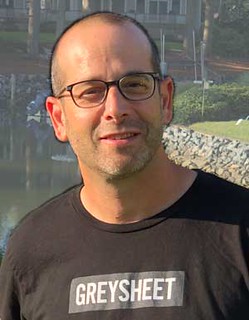 For the first time in 5 years since I've taken over the helm as publisher here at the Greysheet, we are witnessing a true groundswell of positive pricing movement. Market-makers are telling me that they are having legitimate difficulty sourcing enough material for their orders. When we discuss price levels, and adjustments to be made, they tell me something to the effect of "it's the wild west all over again. People are quoting numbers for coins that are higher than we sold them for a week ago. Sometimes we buy them, sometimes we pass."
For the first time in 5 years since I've taken over the helm as publisher here at the Greysheet, we are witnessing a true groundswell of positive pricing movement. Market-makers are telling me that they are having legitimate difficulty sourcing enough material for their orders. When we discuss price levels, and adjustments to be made, they tell me something to the effect of "it's the wild west all over again. People are quoting numbers for coins that are higher than we sold them for a week ago. Sometimes we buy them, sometimes we pass."
Thus is the state of the fluid market right now. Especially for circulated coins or raw mint state/proof 20th century pieces, it's a seller's market and buyers are taking risk when deciding whether to step up and reinforce their depleted inventories. The most interesting part of this momentum is the foundation in the so-called cheaper coins, not the prized certified rarities that appear in live auction—though I suspect this part of the market will follow in short order.
For now, dealers are informing us of emergency-low levels of inventory in circ-MS63 Morgan dollars, for example, which have laid dormant for years. Demand for this series is at a level not seen in years!
To read the complete article, see:
Publishers Message: Wholesale Prices Starting to Show Positive Movement Across the Board (October 2020 Greysheet)
(https://www.greysheet.com/news/story/publishers-message-wholesale-prices-starting-to-show-positive-movement-across-the-board-october-2020-greysheet)
Sports Cards' Biggest Boom
The sports card collecting market is booming as well. Here's an excerpt from an extensive report from ESPN. See the complete article online. -Editor
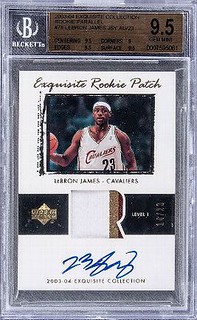 Over the past half-decade, even now amid a pandemic that's decimated the American economy, contemporary sports cards have attracted gargantuan sums from high-rolling investors. And somehow, during a year that included the sharpest GDP quarterly contraction in American history, card sales have demolished all-time records, dumbfounding investors and collectors alike.
Free market capitalism is, if nothing else, adept at creating bubble economies. Amid the wreckage of this so-called junk wax era, as America's 10,000 brick-and-mortar card stores dwindled into the hundreds, List -- now Dr. List, an economics professor at the University of Chicago, short-listed for a 2015 Nobel Prize -- brought academic rigor to his passion.
Over the past half-decade, even now amid a pandemic that's decimated the American economy, contemporary sports cards have attracted gargantuan sums from high-rolling investors. And somehow, during a year that included the sharpest GDP quarterly contraction in American history, card sales have demolished all-time records, dumbfounding investors and collectors alike.
Free market capitalism is, if nothing else, adept at creating bubble economies. Amid the wreckage of this so-called junk wax era, as America's 10,000 brick-and-mortar card stores dwindled into the hundreds, List -- now Dr. List, an economics professor at the University of Chicago, short-listed for a 2015 Nobel Prize -- brought academic rigor to his passion.
"I looked for the best ways to negotiate, the best auction types to sell your cards, how trustworthy dealers were when promising specific grades, loss aversion," List says today, describing work that ultimately yielded some of the earliest field experiments in economics on sports cards.
If anyone in America truly understands baseball cards -- and can explain the seemingly inexplicable boom in their market since the onset of the global pandemic -- it's List.
Before COVID-19 hit, he spent time at spring training in Phoenix and visited his go-to mom and pop shop, AZ Sports Cards, an establishment so warm and welcoming that it's called the sports card version of "Cheers."
"The shop is doing OK," List says. "But the [owner says] the real money is online."
The rise of eBay, Amazon and newer marketplaces like StockX gave birth to huge secondary markets and fierce global competition for sports' most coveted stars, which in turn sent prices skyrocketing.
To read the complete article, see:
How the coronavirus, the internet and tons of money unexpectedly fueled sports cards' biggest boom
(https://www.espn.com/espn/story/_/id/30009629/how-coronavirus-internet-tons-money-unexpectedly-fueled-sports-cards-biggest-boom)
Abraham Accord Medal
Arthur Shippee passed along this article from The Jerusalem Post about a medal created for the recent Abraham Accord. Thanks. -Editor
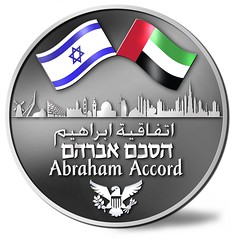
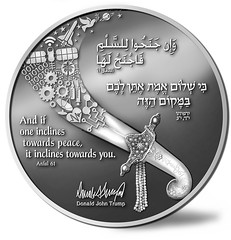
Temple Coins has minted a commemorative medallion in honor of the signing of the Abraham Accord between the United Arab Emirates and Israel, the coin maker announced in a statement.
The coin, designed by numismatic artist Aharon Shavo, shows the Israeli and UAE flags prominently displayed on the front, flying over the silhouette of Jerusalem's Old City conjoined with the Abu Dhabi skylines.
Engraved below the skyline are the words "Abraham Accord," written in Arabic, Hebrew and English.
The biblical founder of Judaism is referred to as Abraham in the Christian faith, as Avraham in Hebrew and as Ibrahim in Arabic.
To read the complete article, see:
Temple Coins introduces limited edition Abraham Accord medallion
(https://www.jpost.com/israel-news/temple-coins-introduces-limited-edition-abraham-accords-medallion-643819)

LOST LANGUAGES DISCOVERED
For bibliophiles, Len Augsburger passed along this Smithsonian article about lost languages discovered by researchers using new techniques. Thanks. -Editor
Saint Catherine's Monastery, a sacred Christian site nestled in the shadow of Mount Sinai, is home to one of the world's oldest continuously used libraries. Thousands of manuscripts and books are kept there—some of which contain hidden treasures.
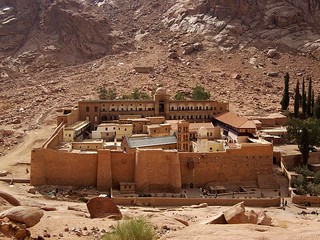 Manuscripts with multiple layers of writing are known as palimpsests, and there are about 130 of them at St. Catherine's Monastery, according to the website of the Early Manuscript Electronic Library, which has been leading the initiative to uncover the original texts. As Richard Gray explains in the Atlantic, with the rise of Islam in the 7th century, Christian sites in the Sinai Desert began to disappear, and Saint Catherine's found itself in relative isolation. Monks turned to reusing older parchments when supplies at the monastery ran scarce.
Manuscripts with multiple layers of writing are known as palimpsests, and there are about 130 of them at St. Catherine's Monastery, according to the website of the Early Manuscript Electronic Library, which has been leading the initiative to uncover the original texts. As Richard Gray explains in the Atlantic, with the rise of Islam in the 7th century, Christian sites in the Sinai Desert began to disappear, and Saint Catherine's found itself in relative isolation. Monks turned to reusing older parchments when supplies at the monastery ran scarce.
To uncover the palimpsests' secret texts, researchers photographed thousands of pages multiple times, illuminating each page with different-colored lights. They also photographed the pages with light shining onto them from behind, or from an oblique angle, which helped "highlight tiny bumps and depressions in the surface," Gray writes. They then fed the information into a computer algorithm, which is able to distinguish the more recent texts from the originals.
Since 2011, researchers have photographed 74 palimpsests, which boast 6,800 pages between them. And the team's results have been quite astonishing. Among the newly revealed texts, which date from the 4th to the 12th century, are 108 pages of previously unknown Greek poems and the oldest-known recipe attributed to the Greek physician Hippocrates.
But perhaps the most intriguing finds are the manuscripts written in obscure languages that fell out of use many centuries ago. Two of the erased texts, for instance, were inked in Caucasian Albanian, a language spoken by Christians in what is now Azerbaijan. According to Sarah Laskow of Atlas Obscura, Caucasian Albanian only exists today in a few stone inscriptions. Michael Phelps, director of the Early Manuscripts Electronic Library, tells Gray of the Atlantic that the discovery of Caucasian Albanian writings at Saint Catherine's library has helped scholars increase their knowledge of the language's vocabulary, giving them words for things like "net" and "fish."
Other hidden texts were written in a defunct dialect known as Christian Palestinian Aramaic, a mix of Syriac and Greek, which was discontinued in the 13th century only to be rediscovered by scholars in the 18th century. "This was an entire community of people who had a literature, art, and spirituality," Phelps tells Gray. "Almost all of that has been lost, yet their cultural DNA exists in our culture today. These palimpsest texts are giving them a voice again and letting us learn about how they contributed to who we are today."
To read the complete article, see:
Lost Languages Discovered in One of the World's Oldest Continuously Run Libraries
(https://www.smithsonianmag.com/smart-news/long-lost-languages-found-manuscripts-egyptian-monastery-180964698/)
FEATURED WEB PAGE: CHILEAN NITRATE TOKENS
This week's Featured Web Page illustrates various forms of Chilean Nitrate Tokens.
Between 1860 and 1920 the use of tokens to pay wages to the workers of the tasks nitrate was common in all of them. A wide varieties of chips in metal: brass, aluminum, copper, lead, nickel. Also there Ebonite and cardboard. There were more than 300 offices nitrate in the former provinces of Tarapaca and Antofagasta.
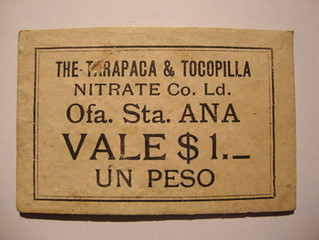
www.collectorsweekly.com/stories/57127-token-nitrate-of-chile

